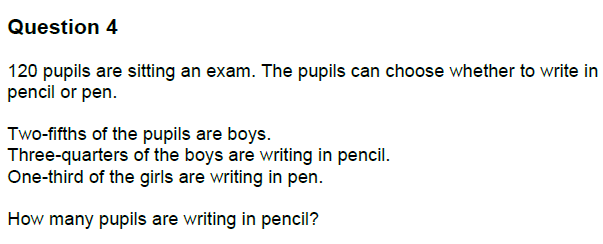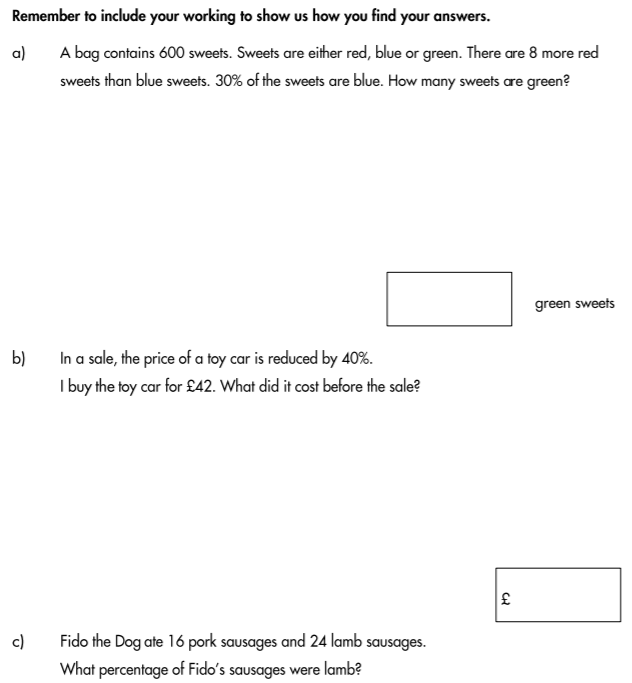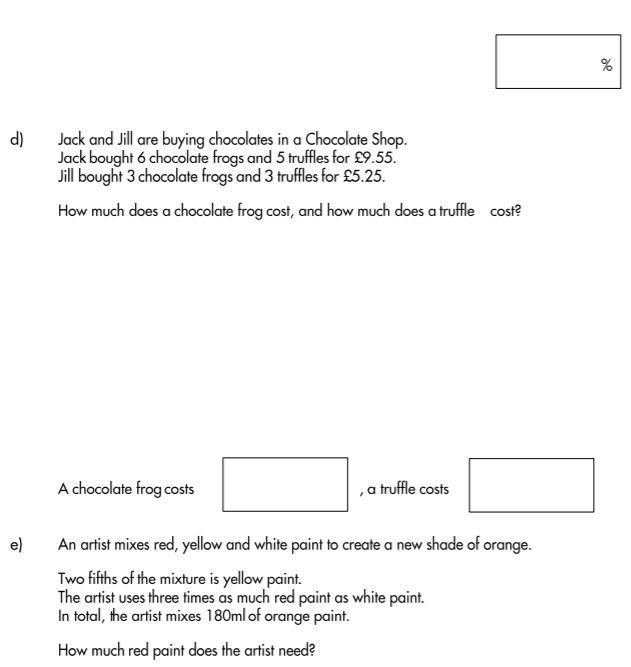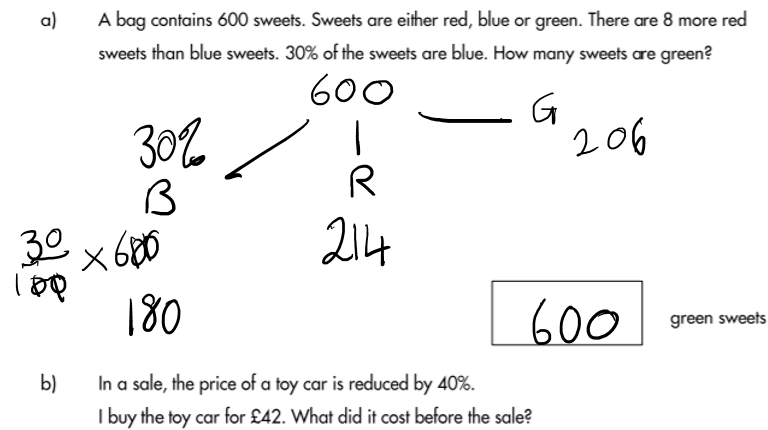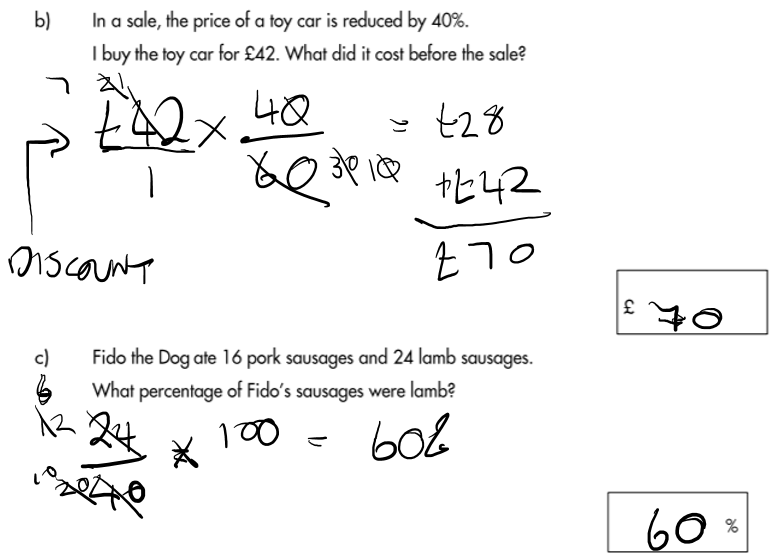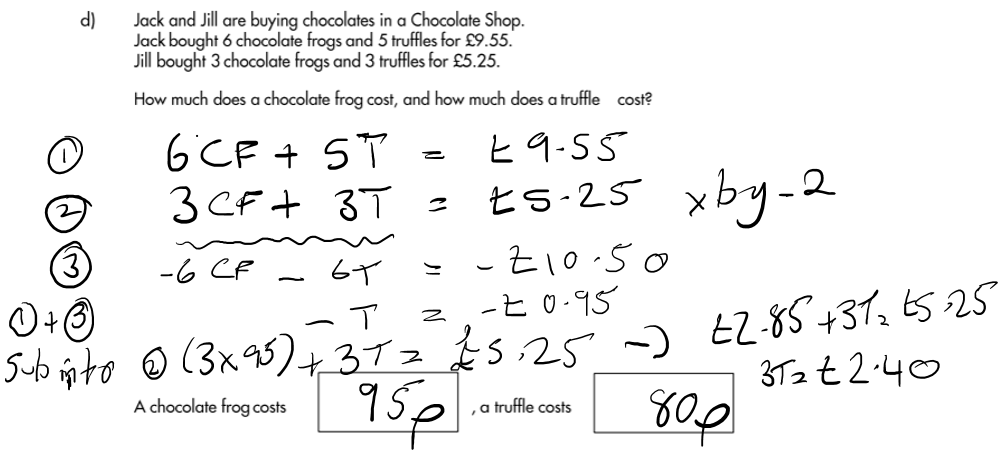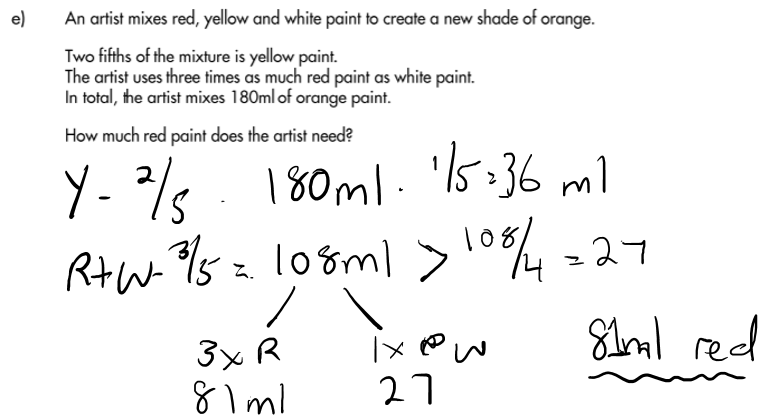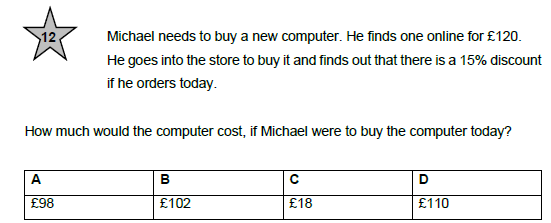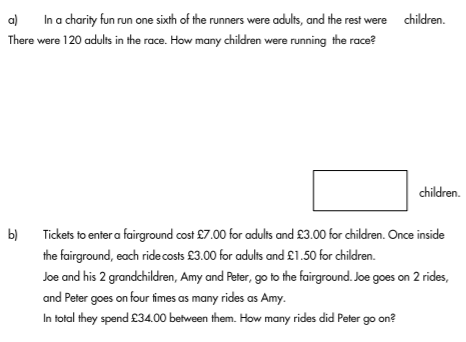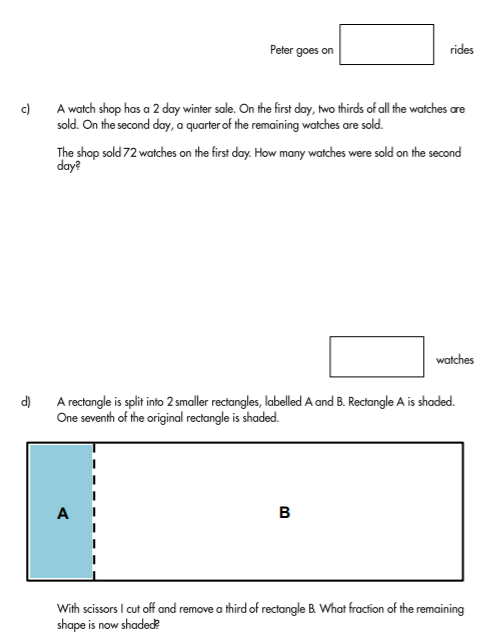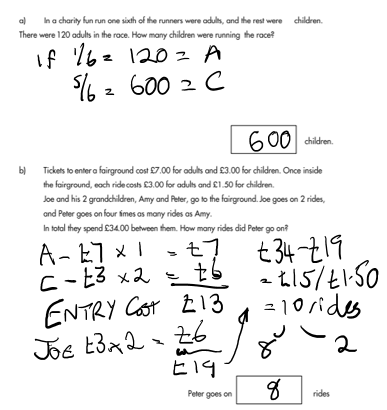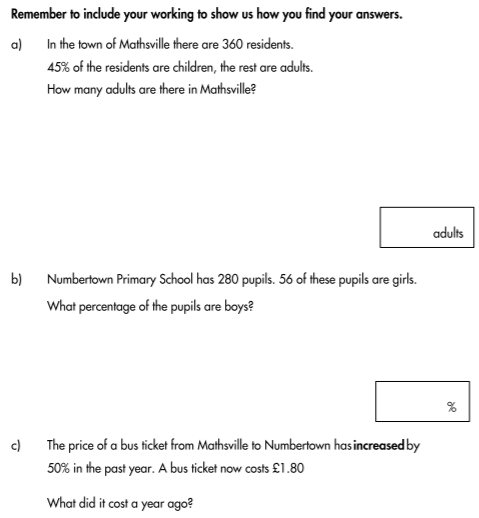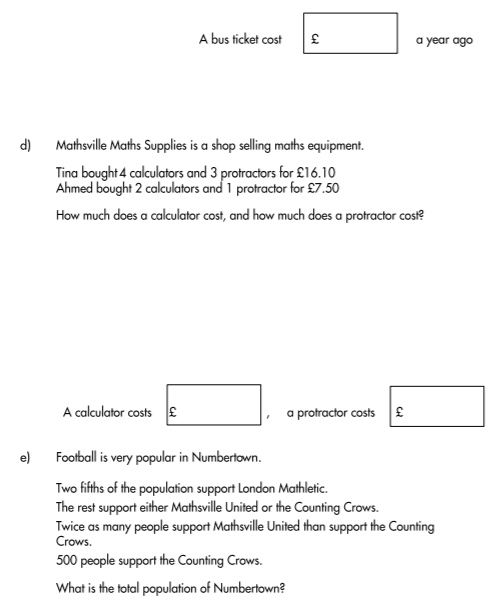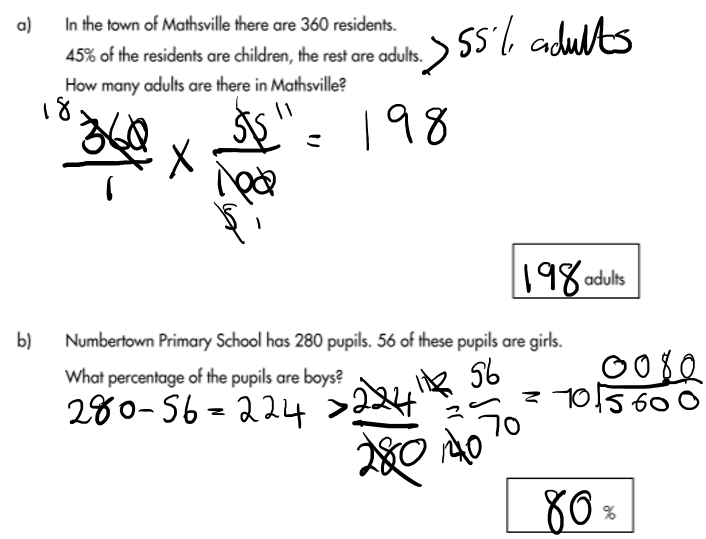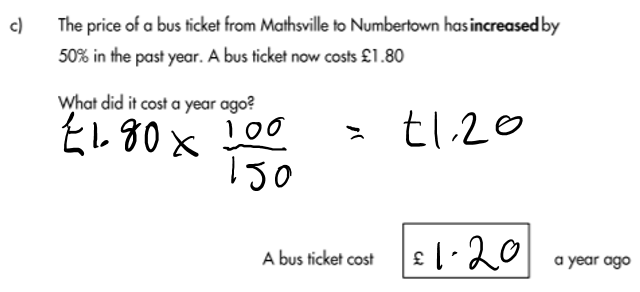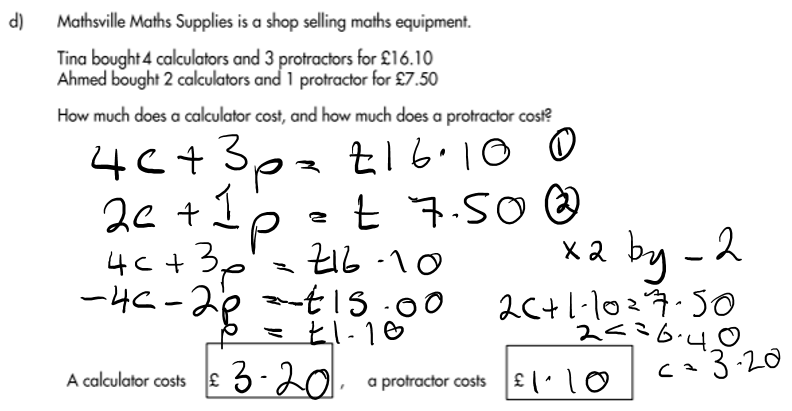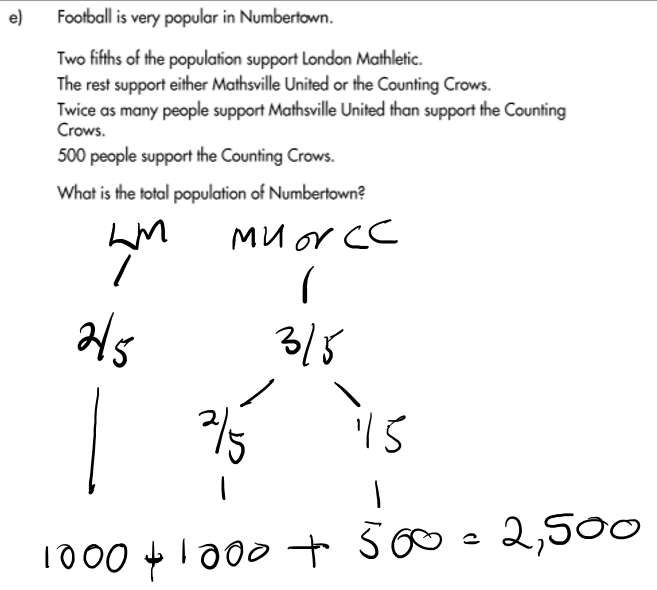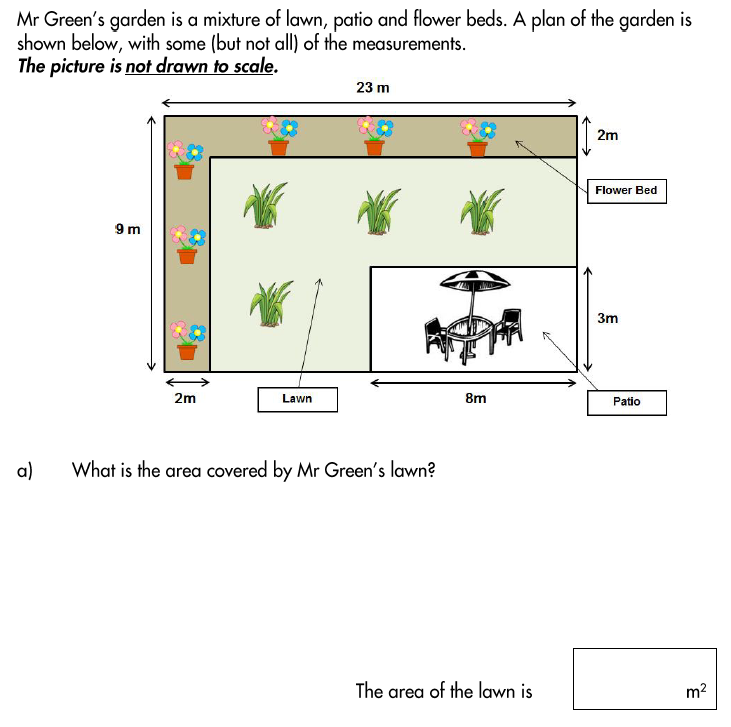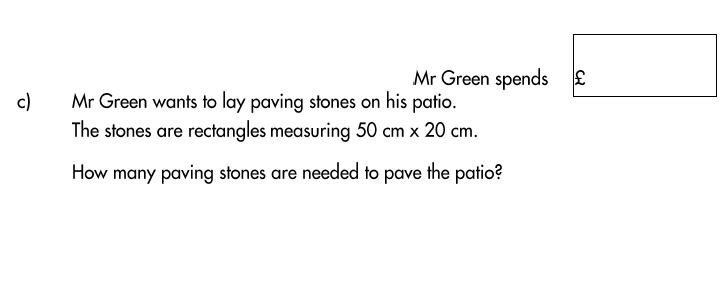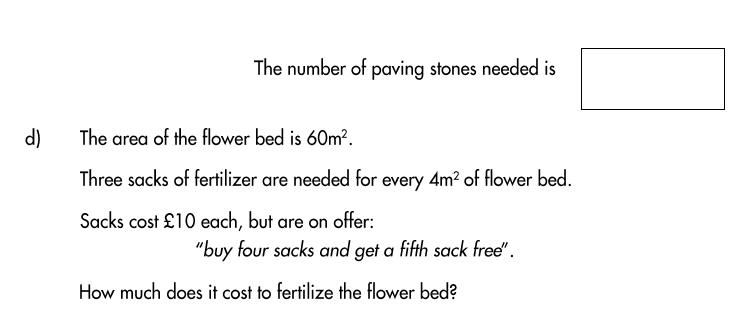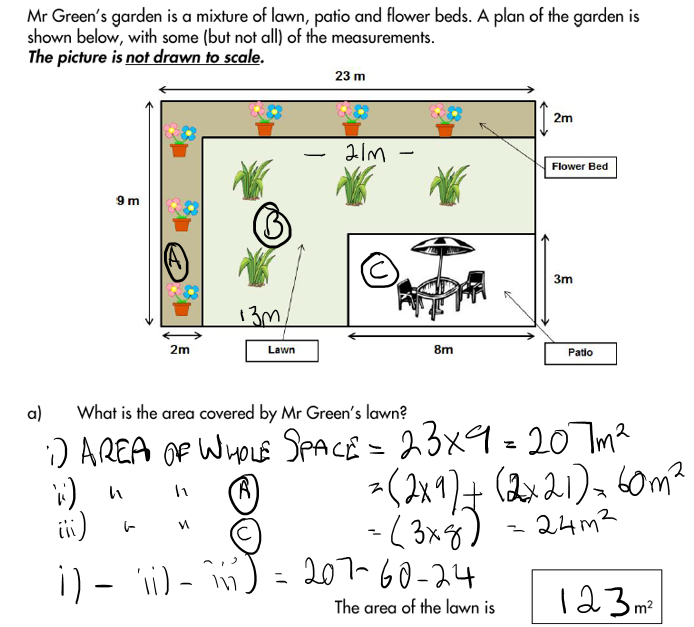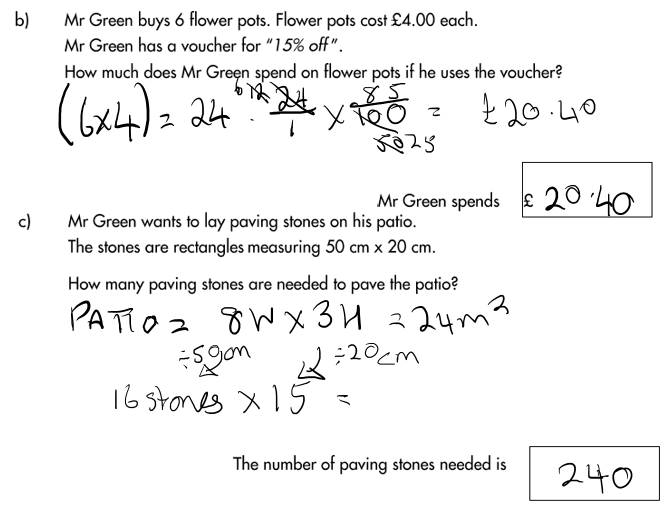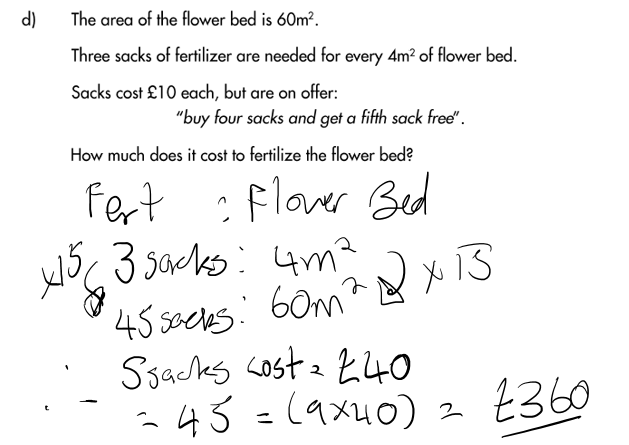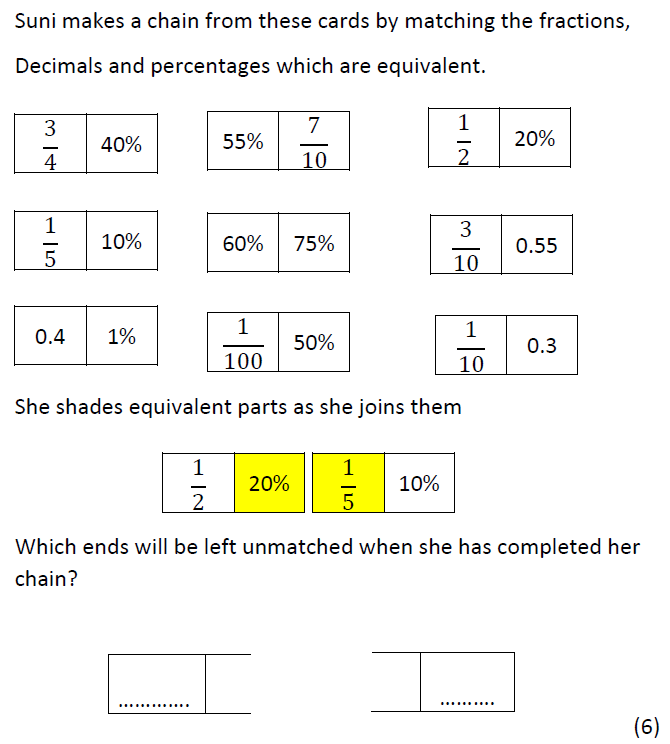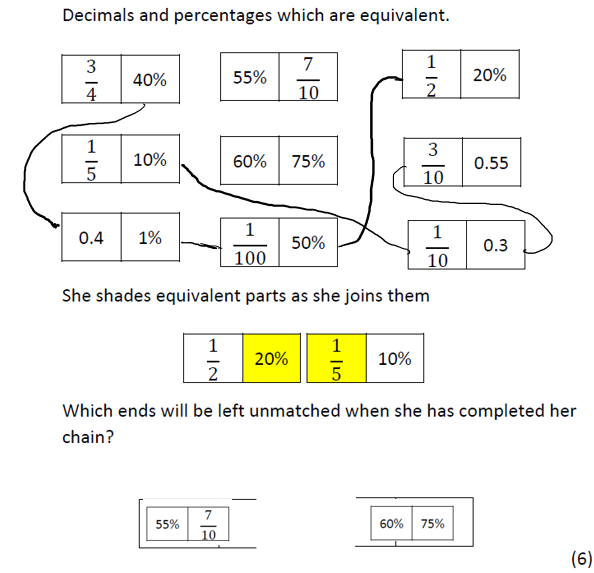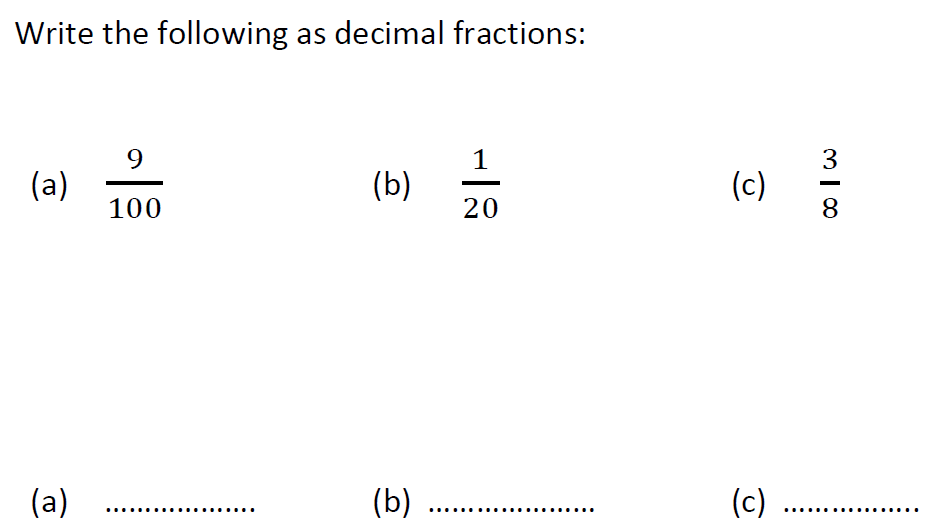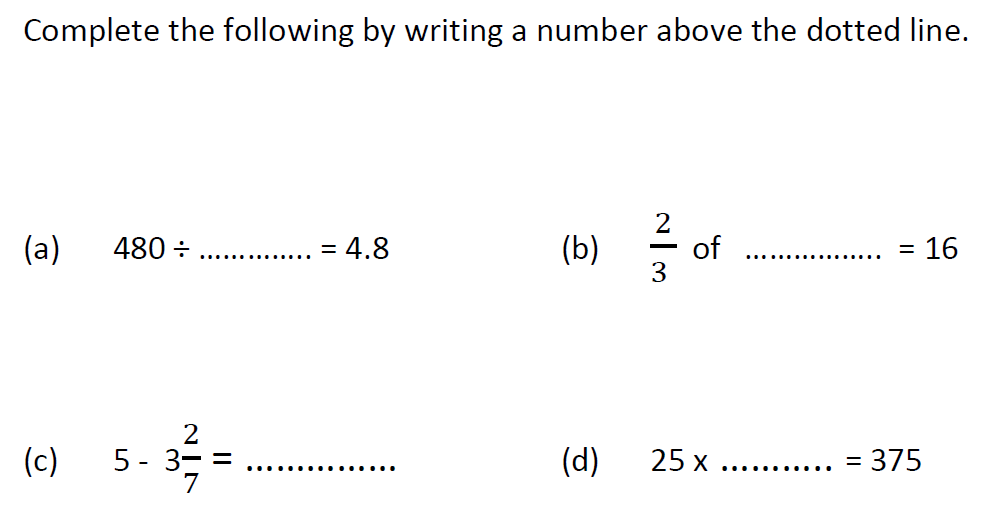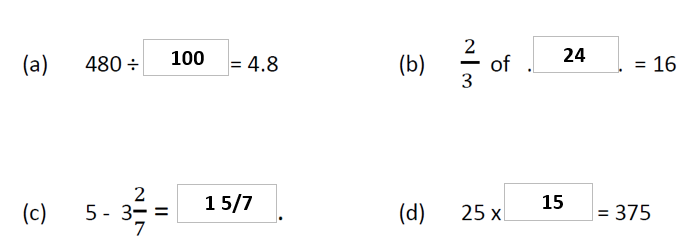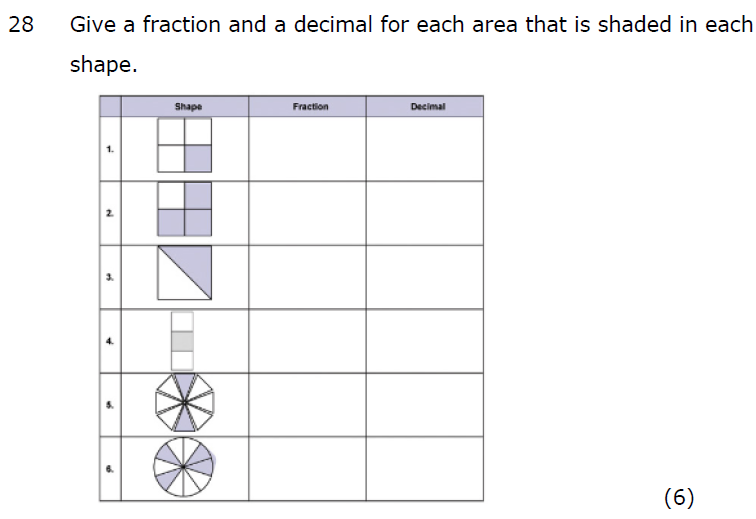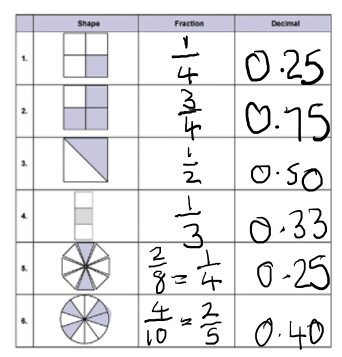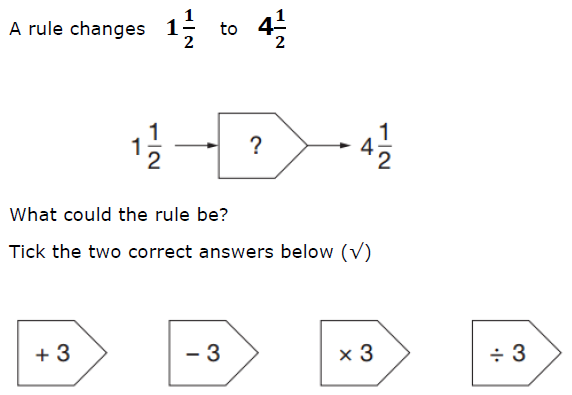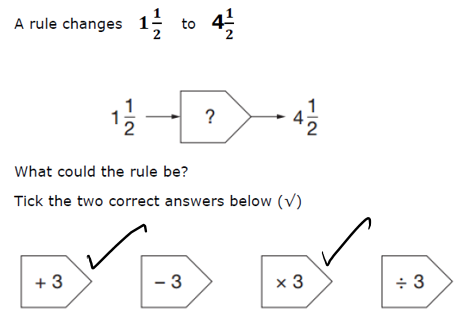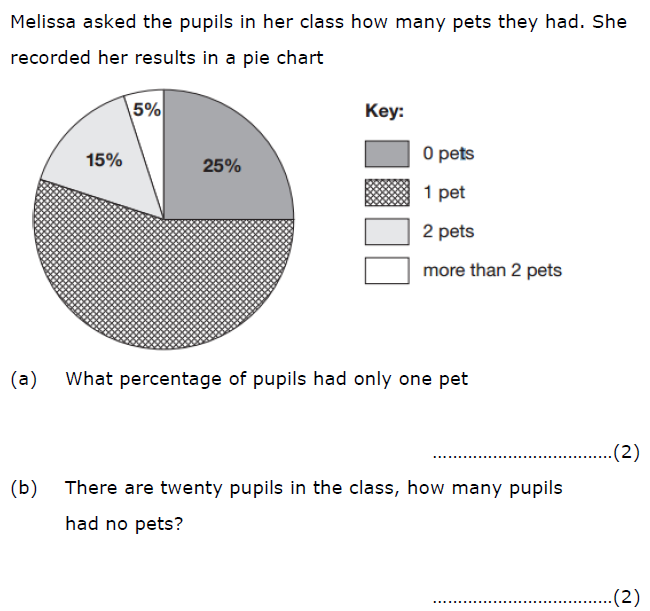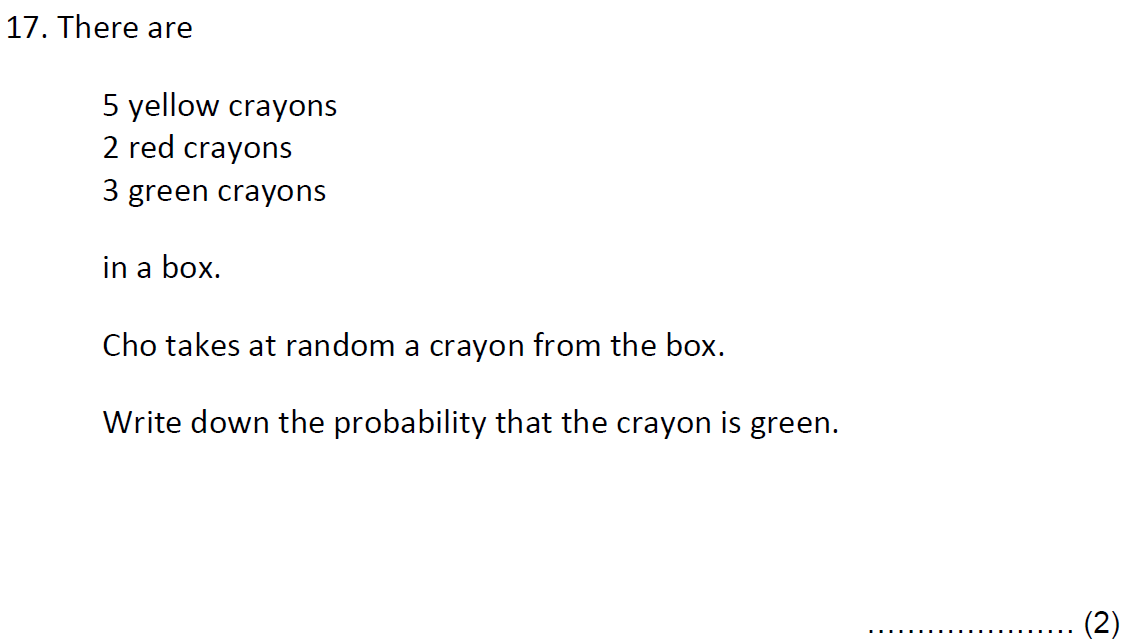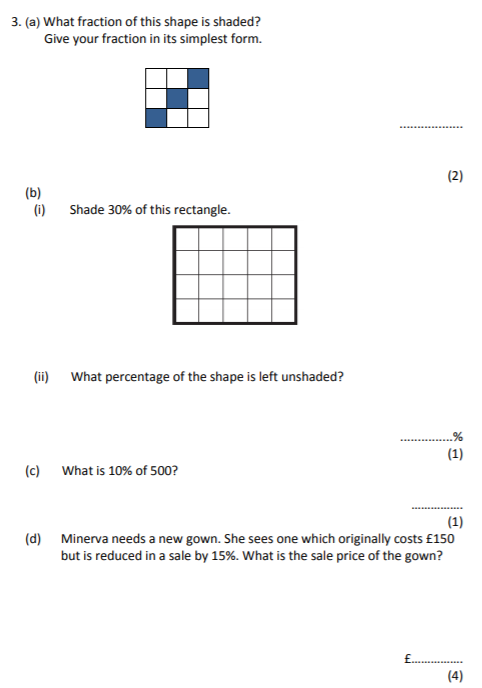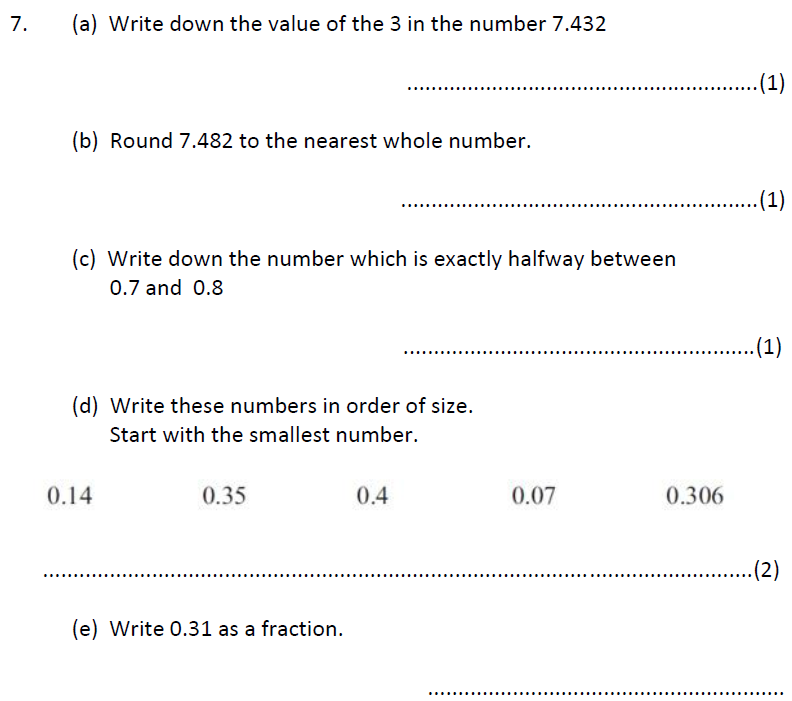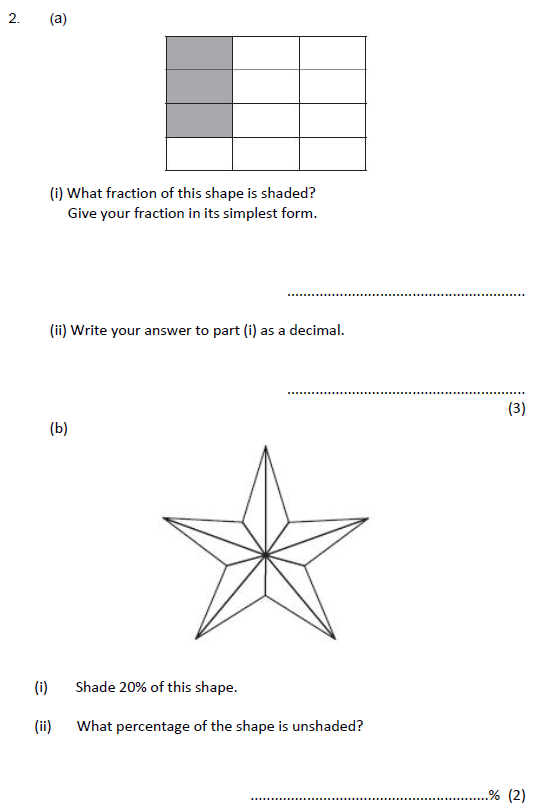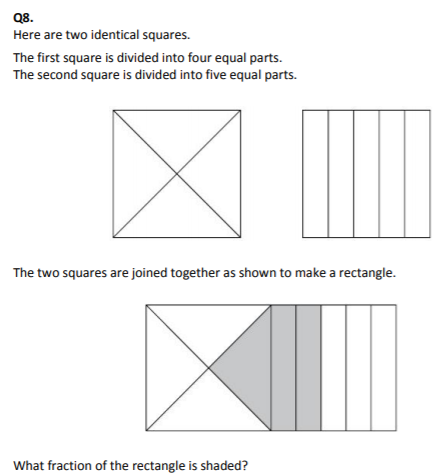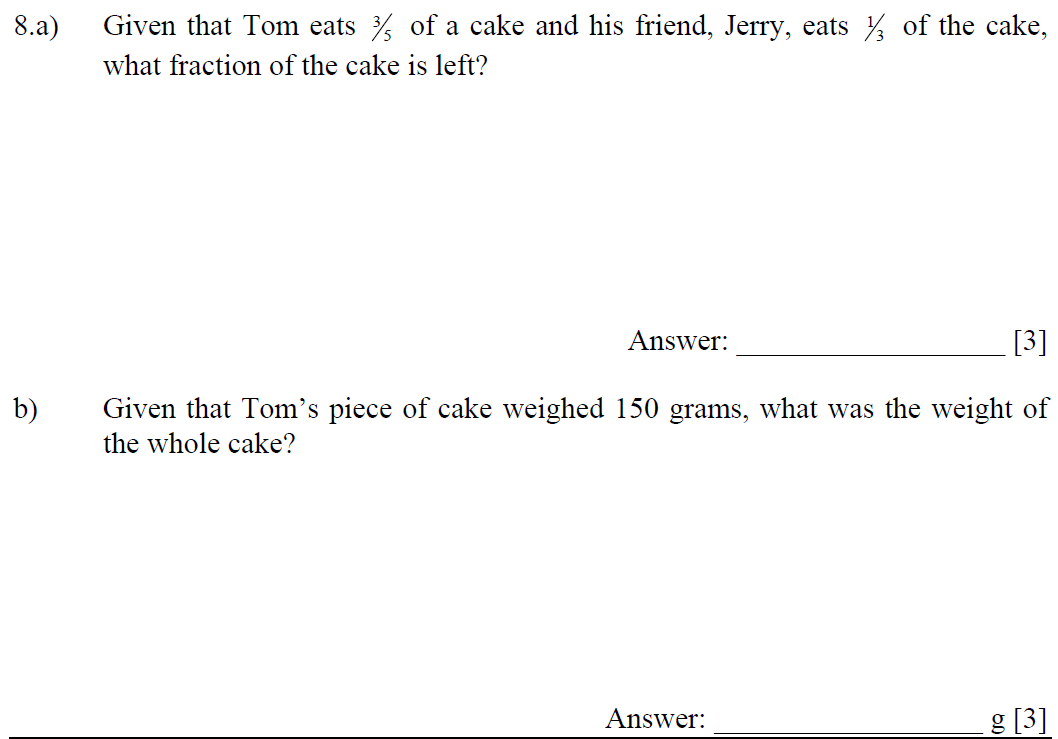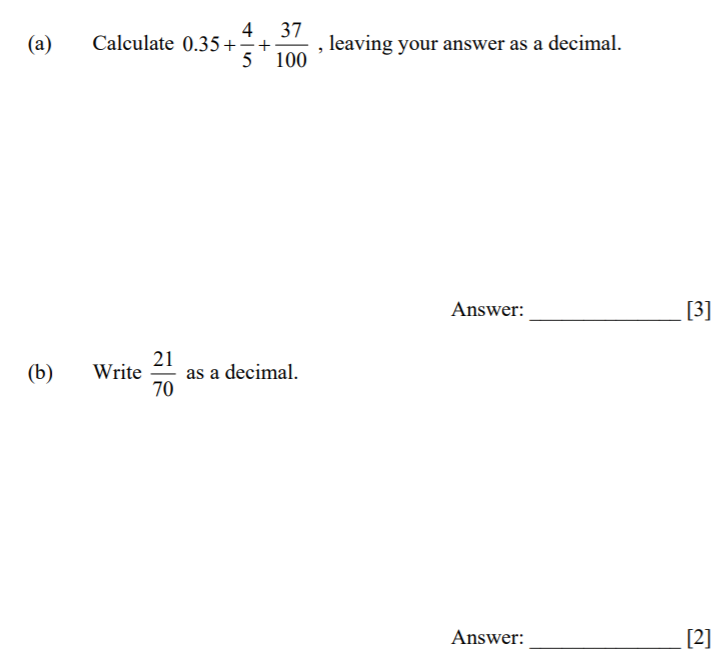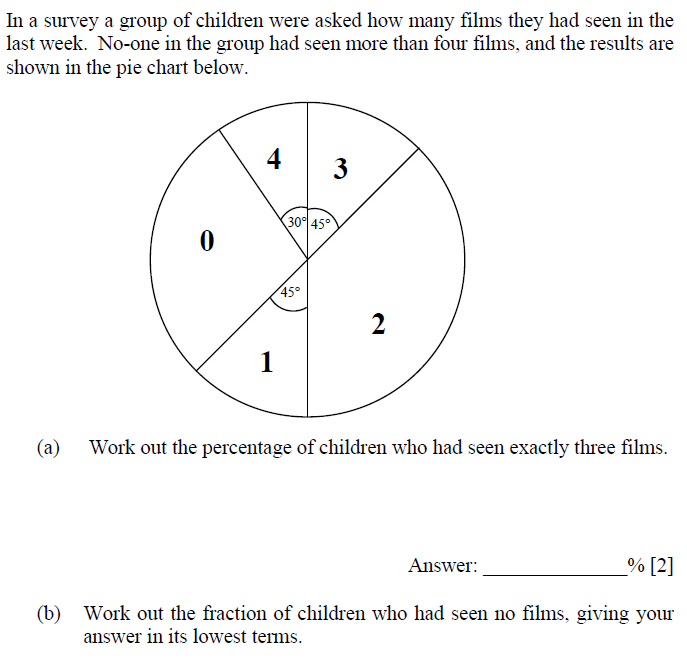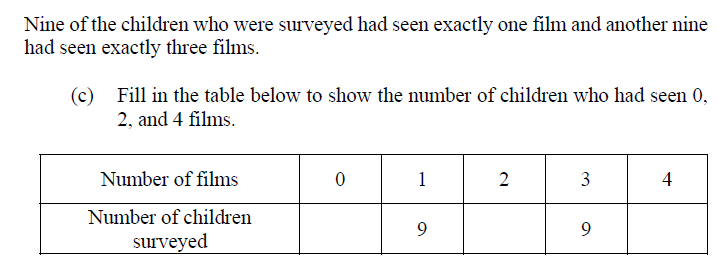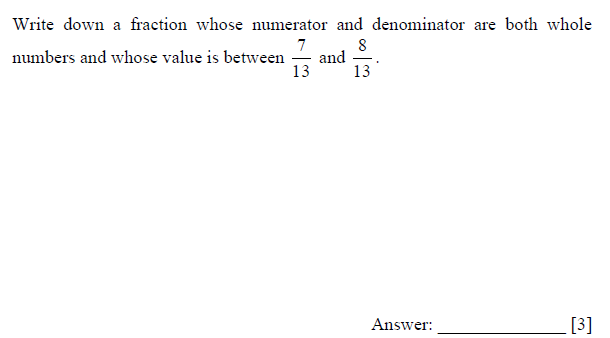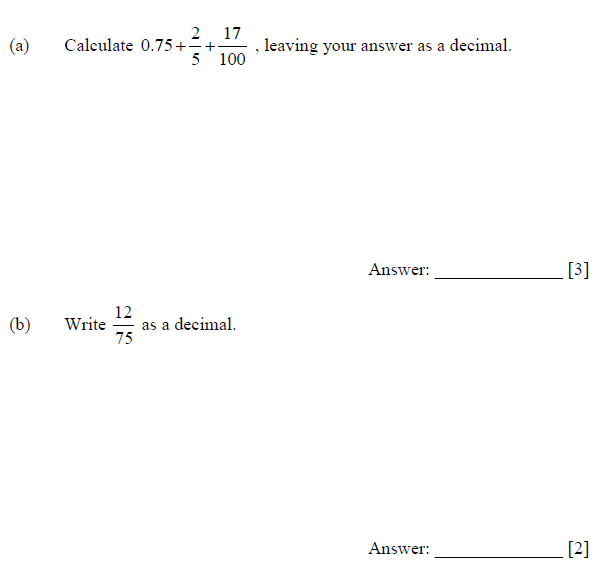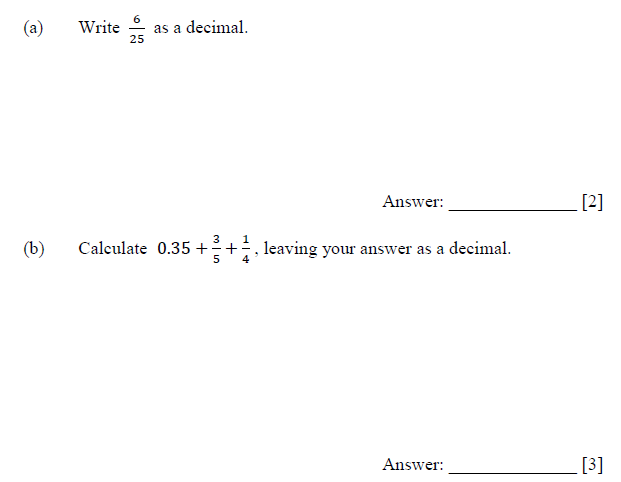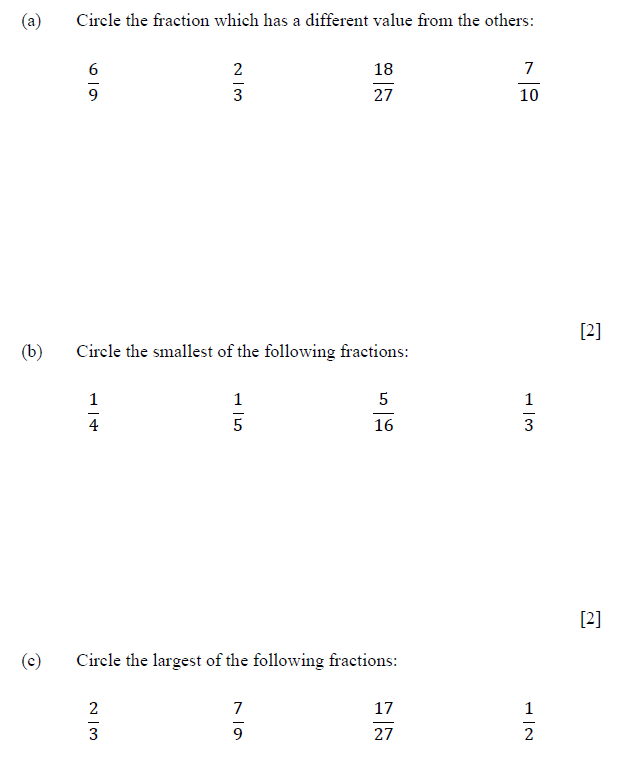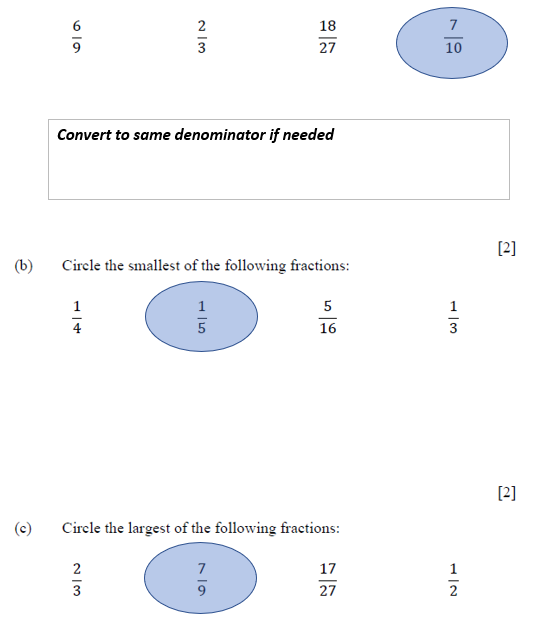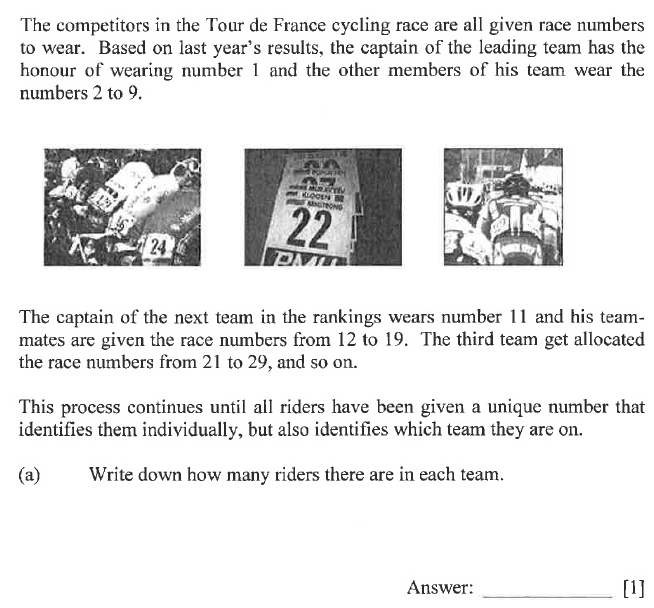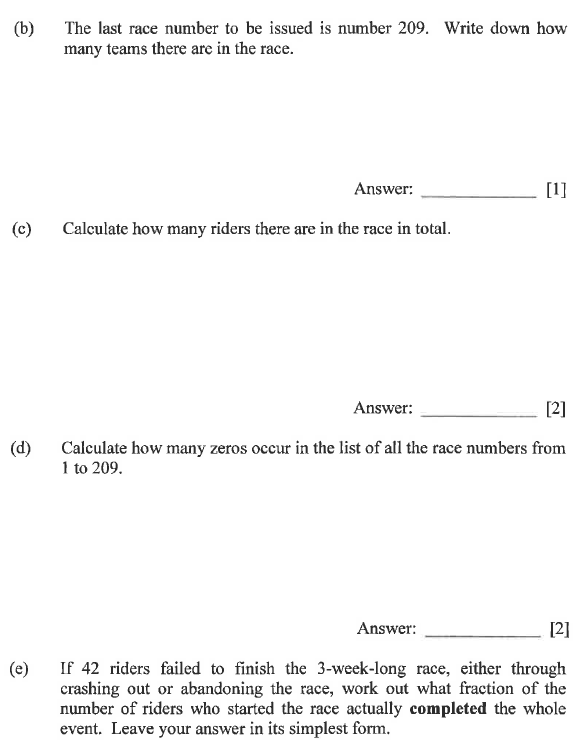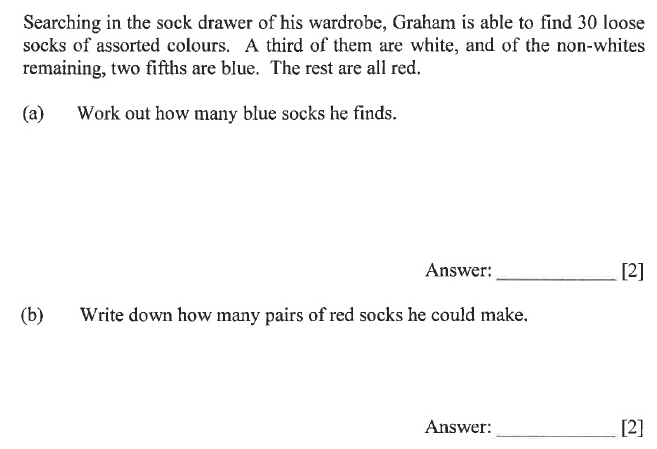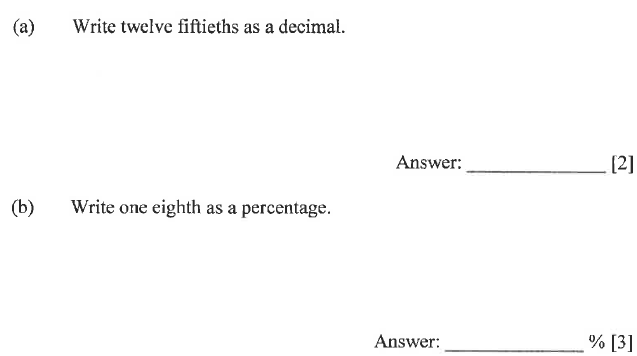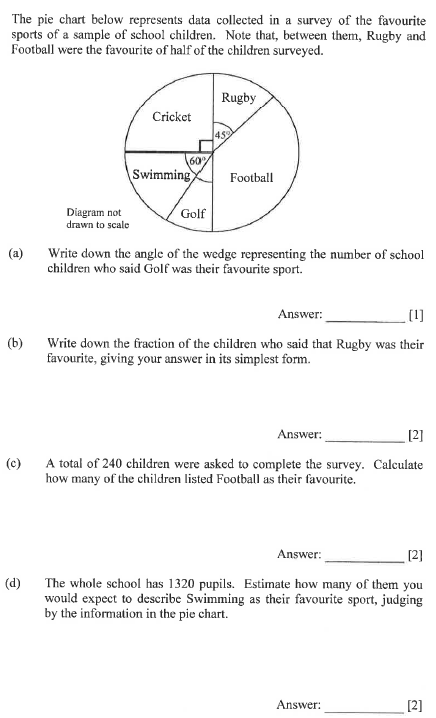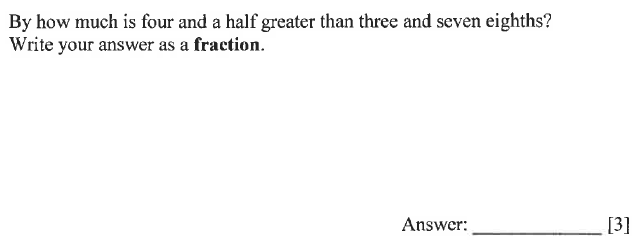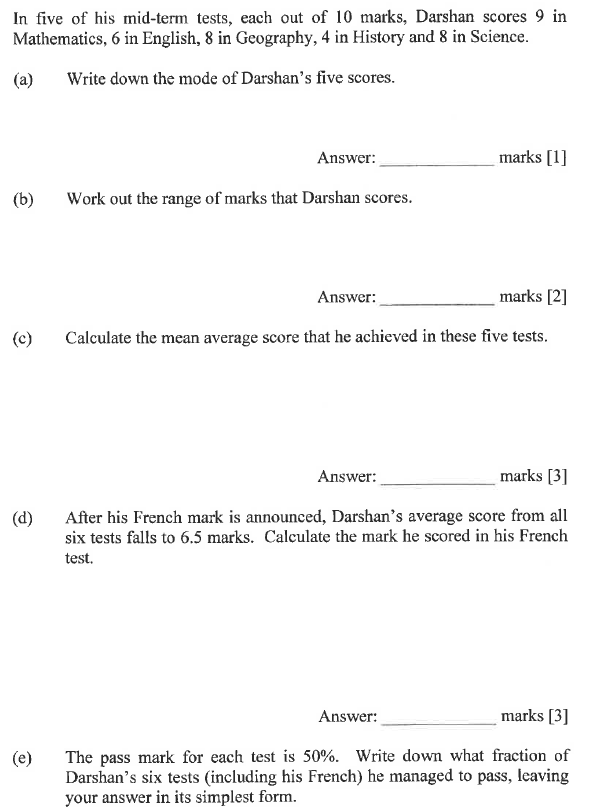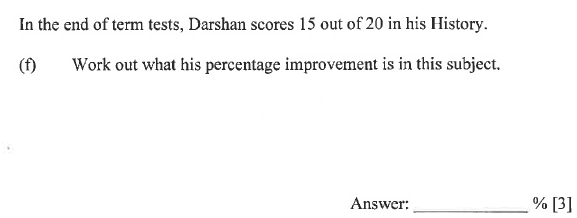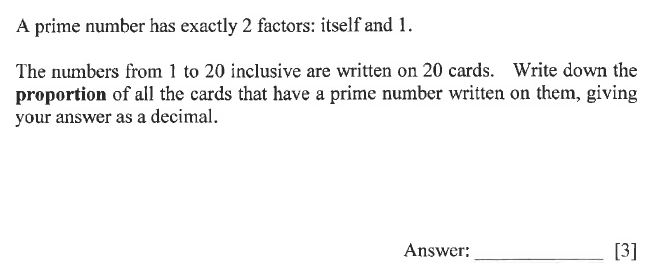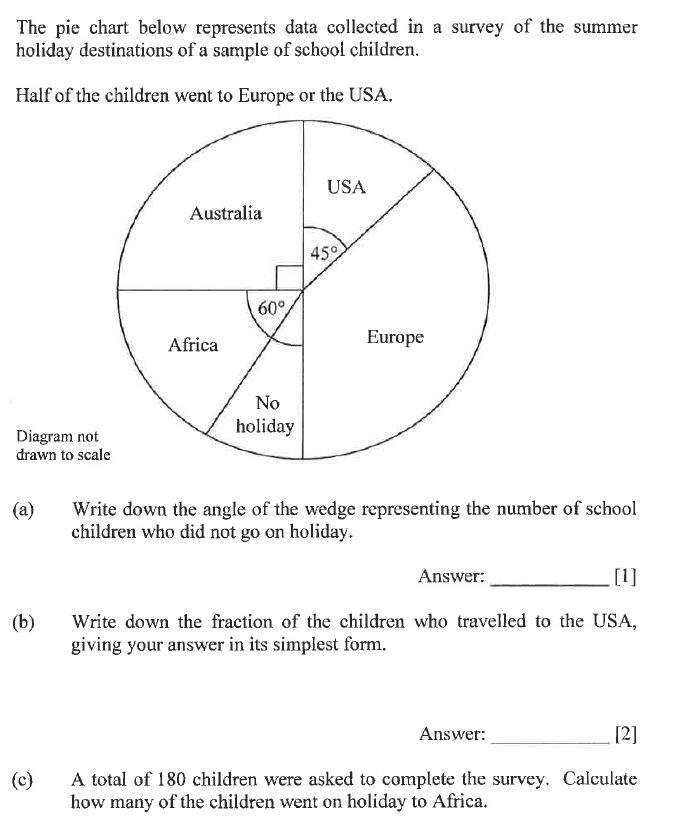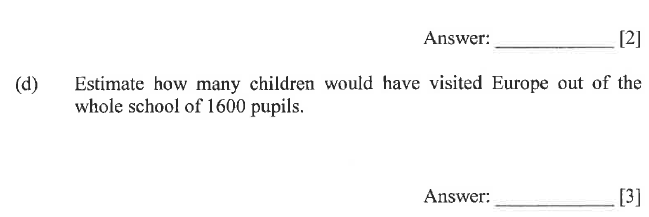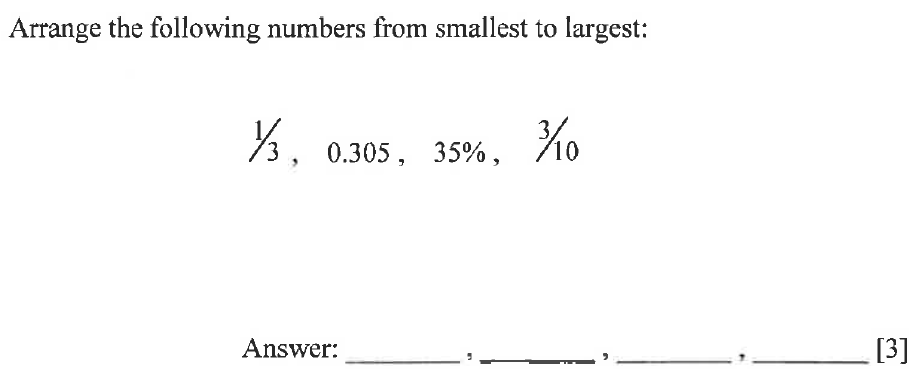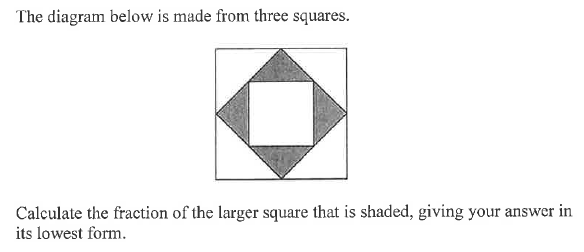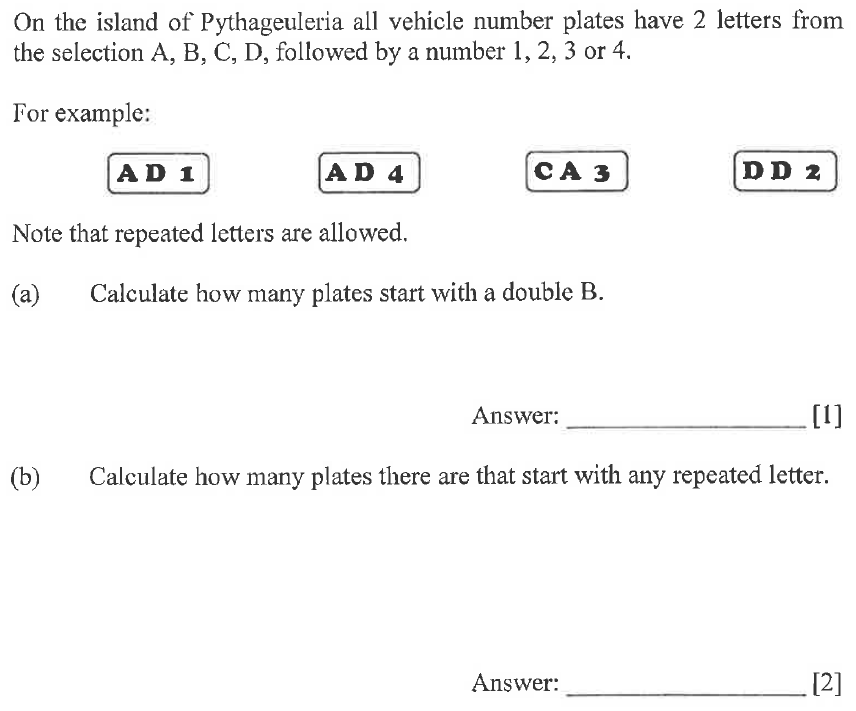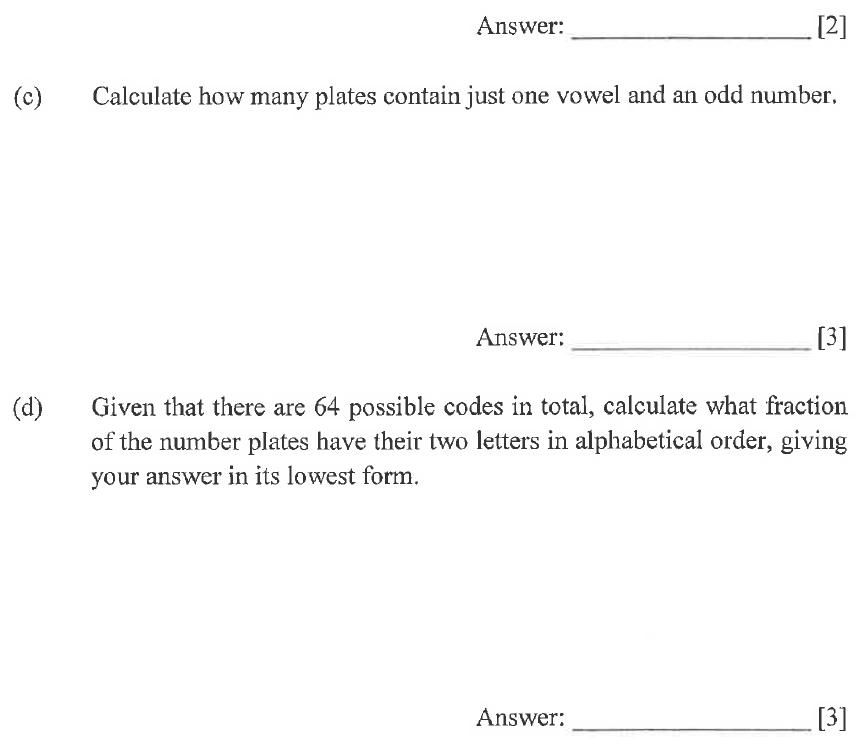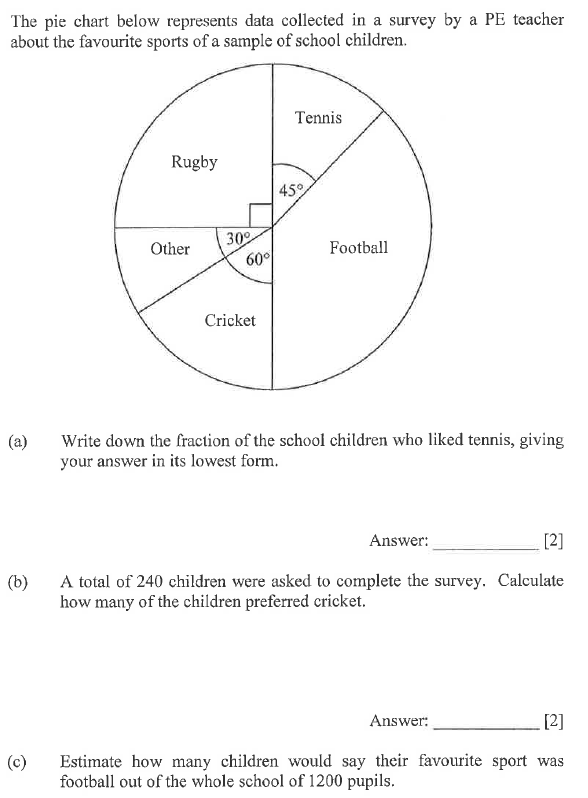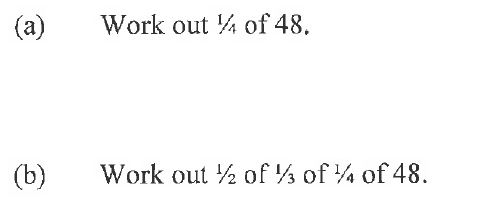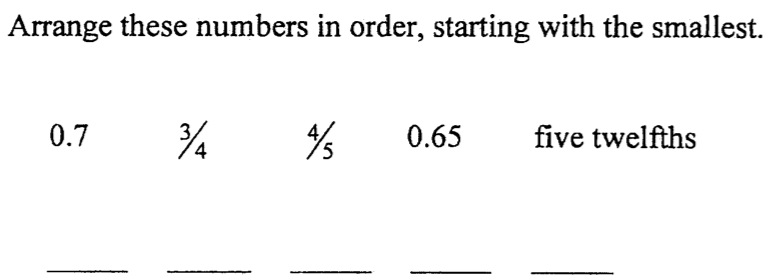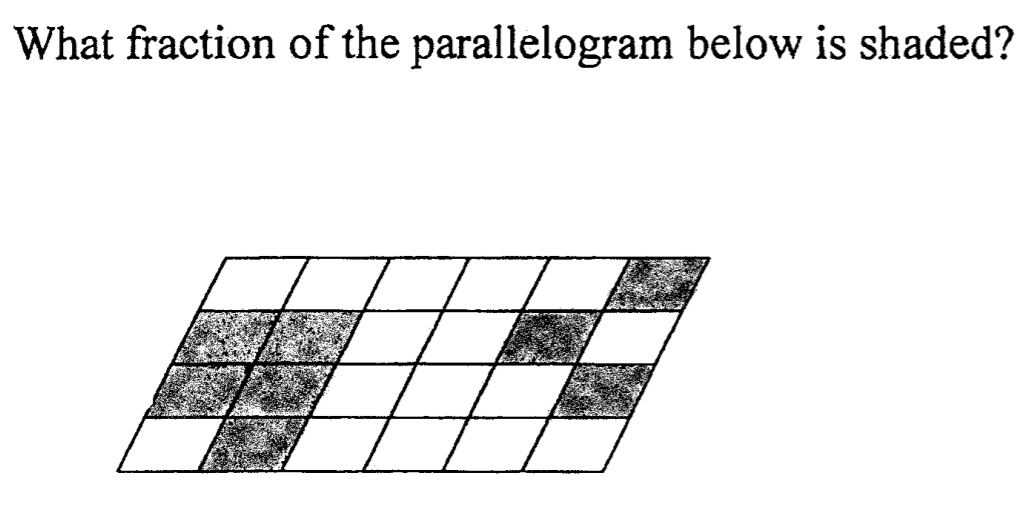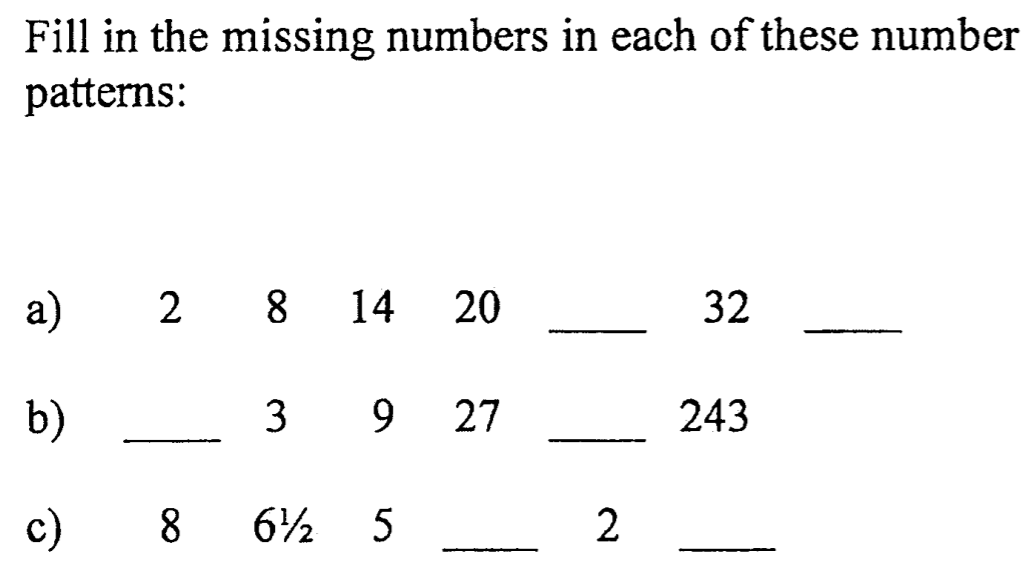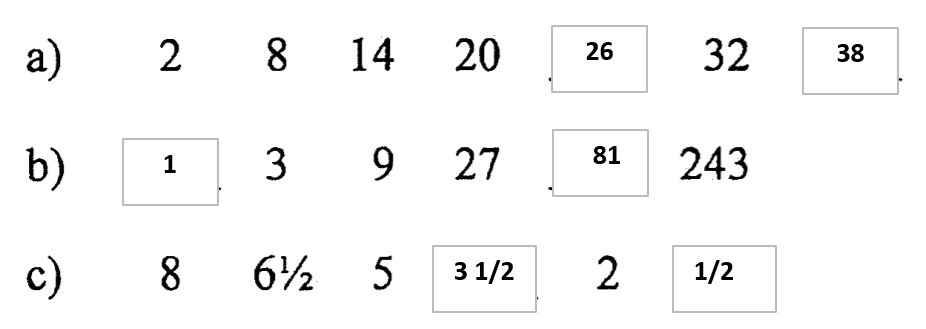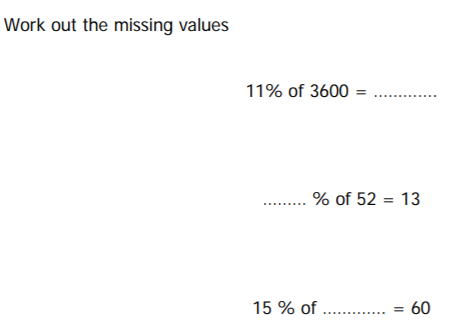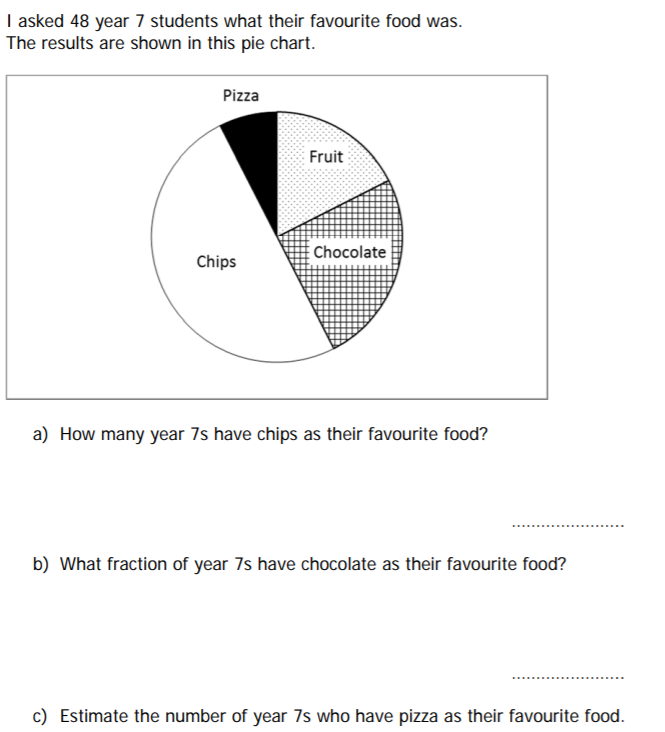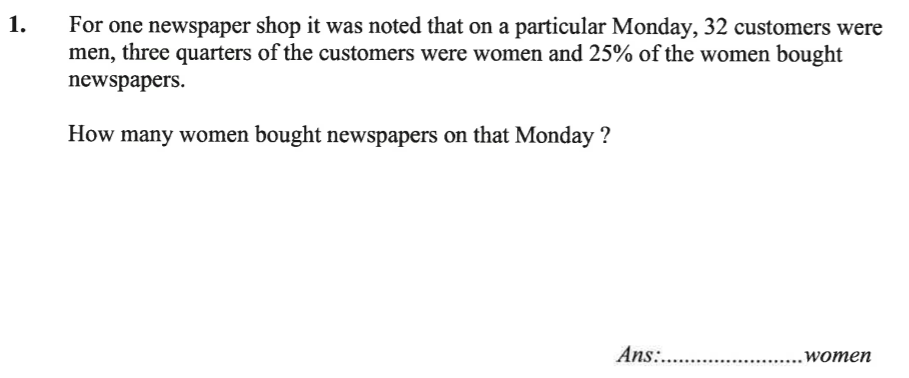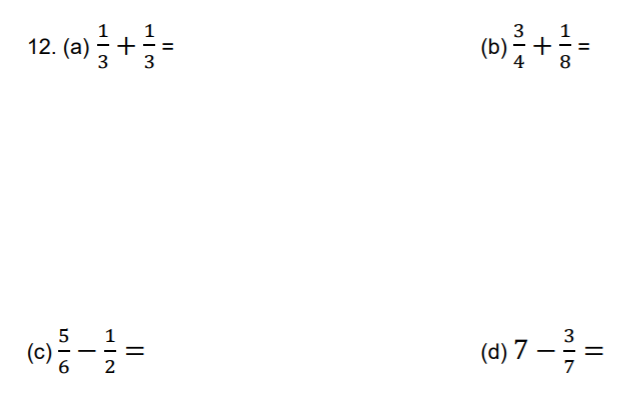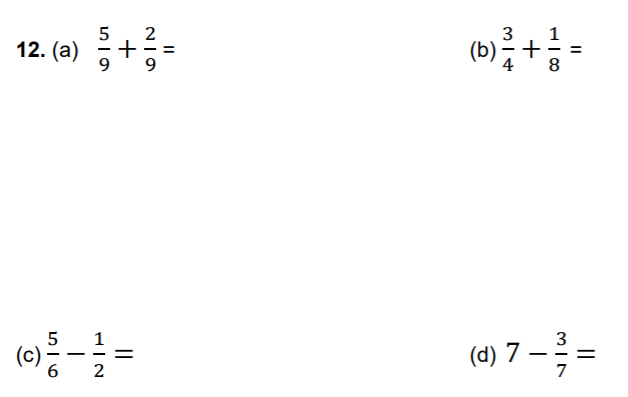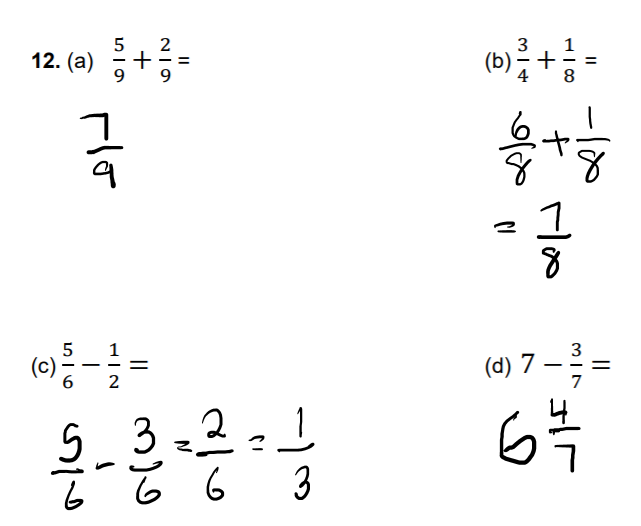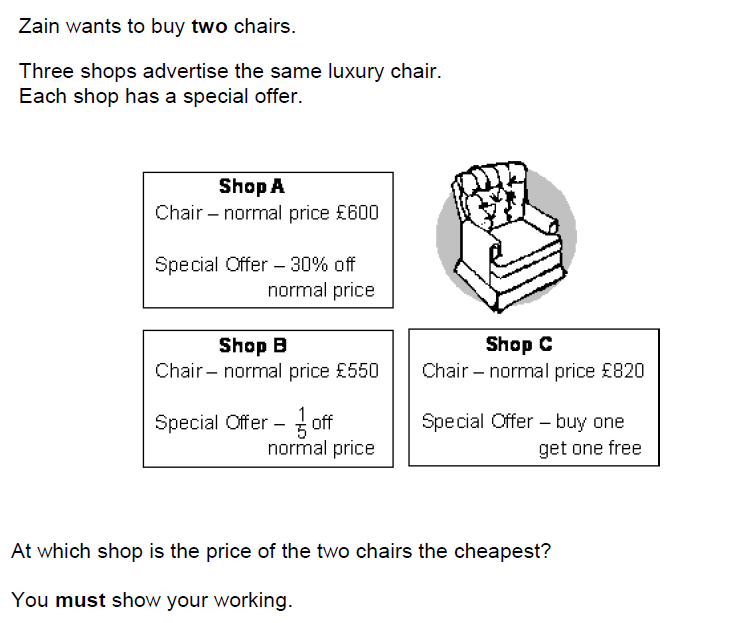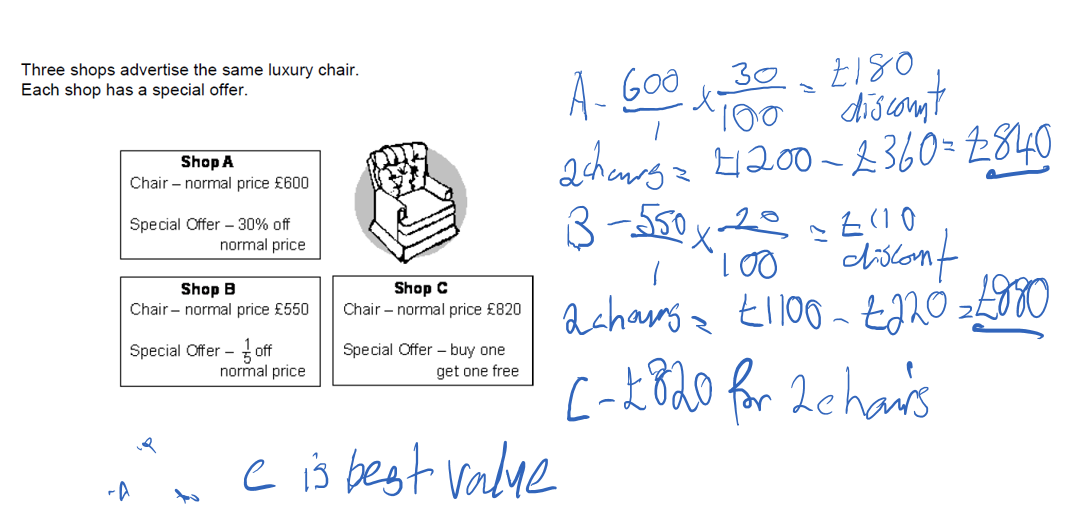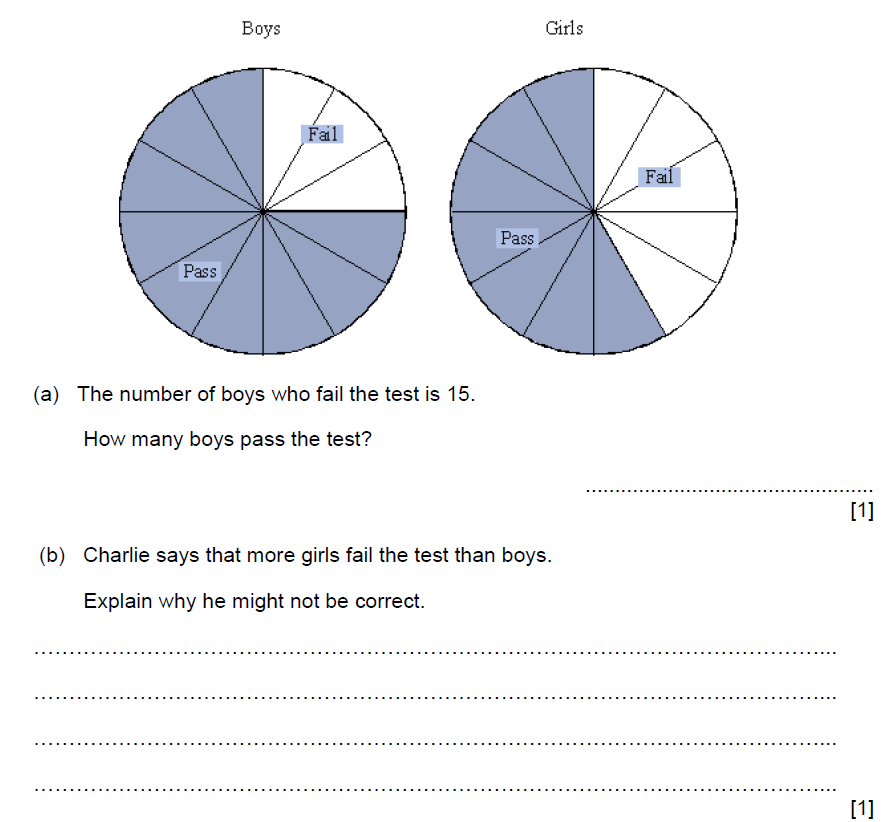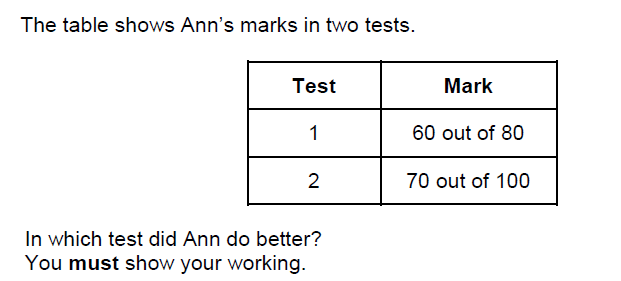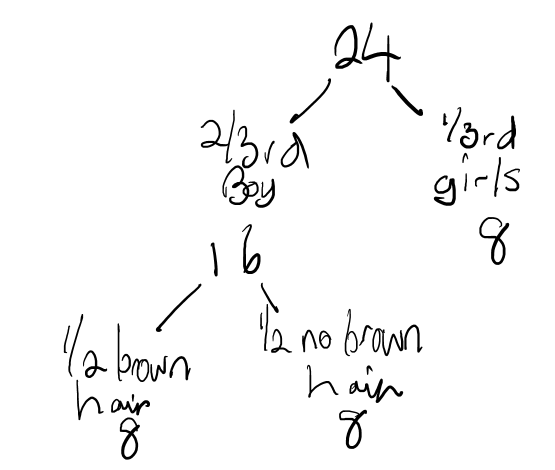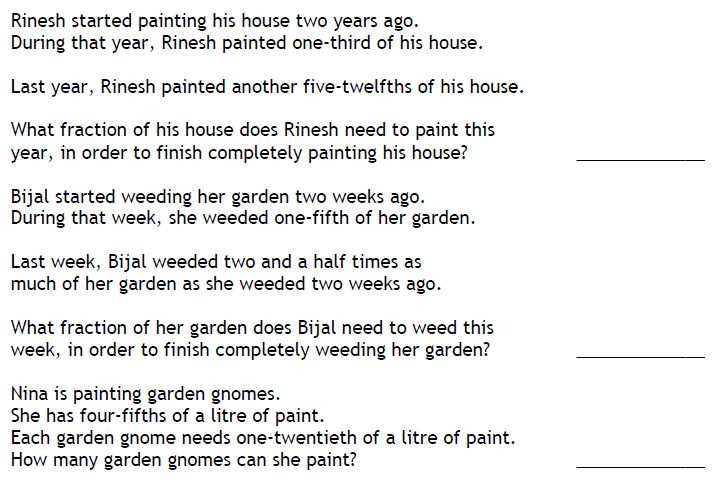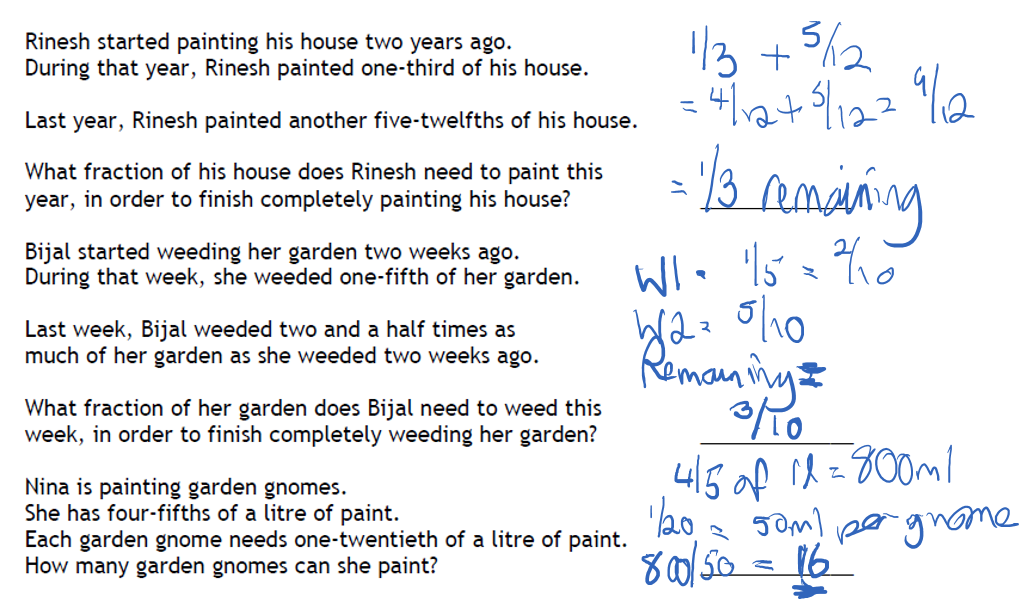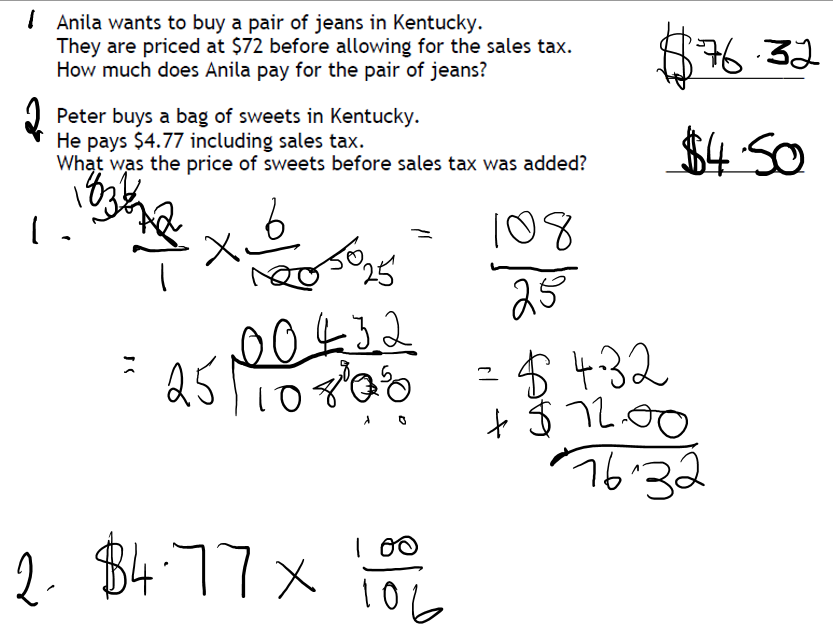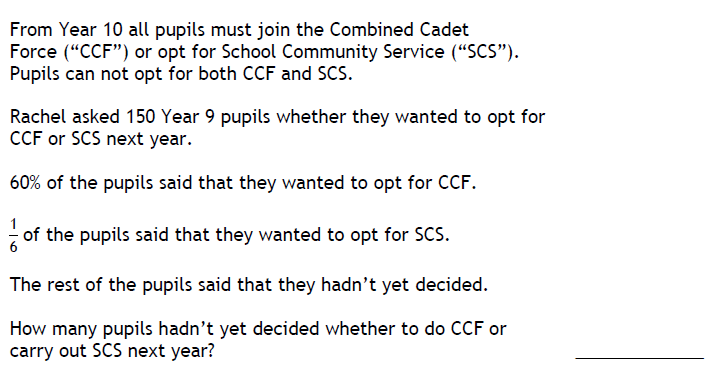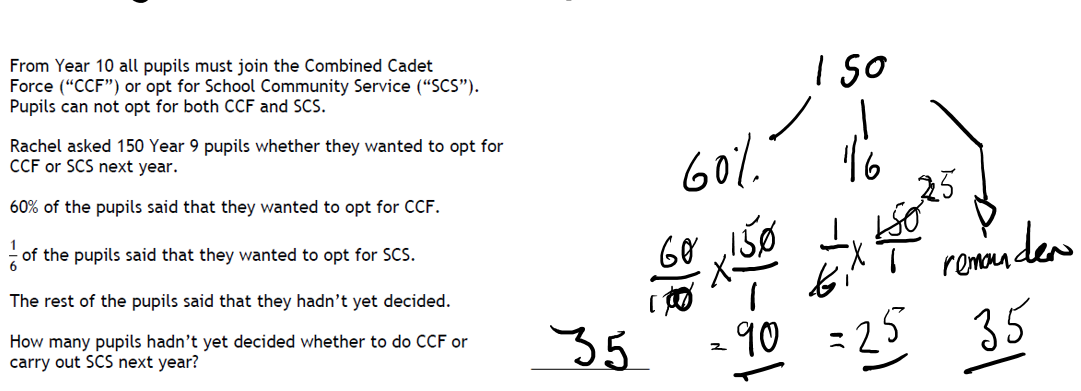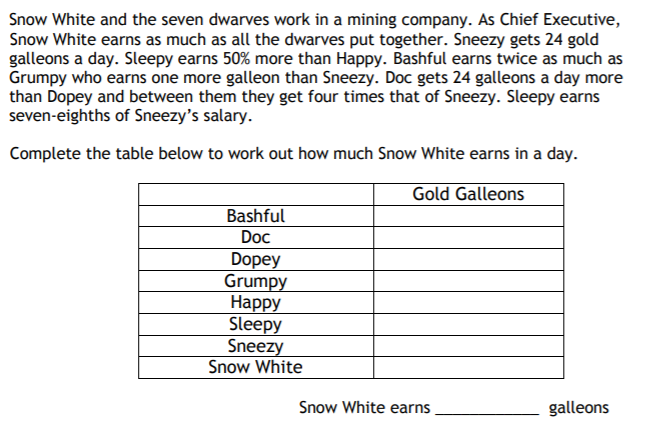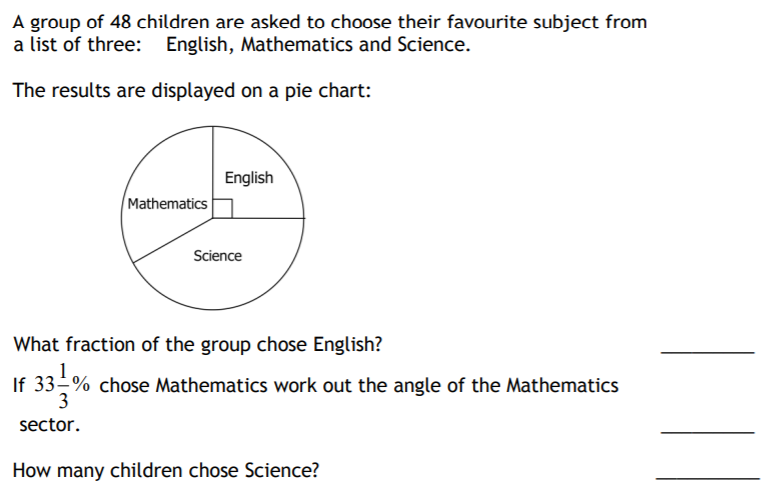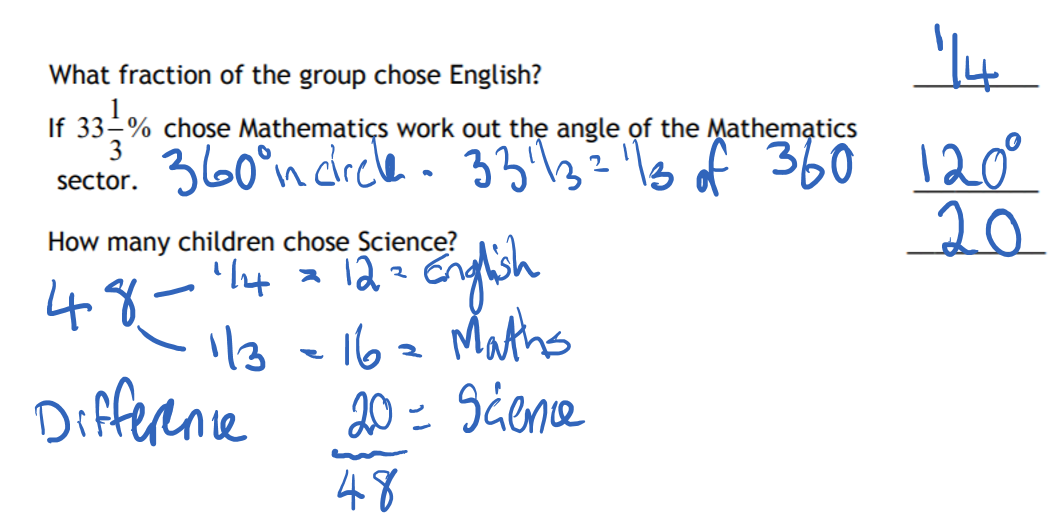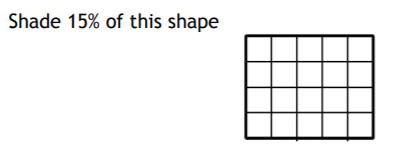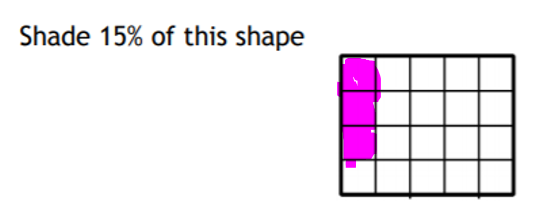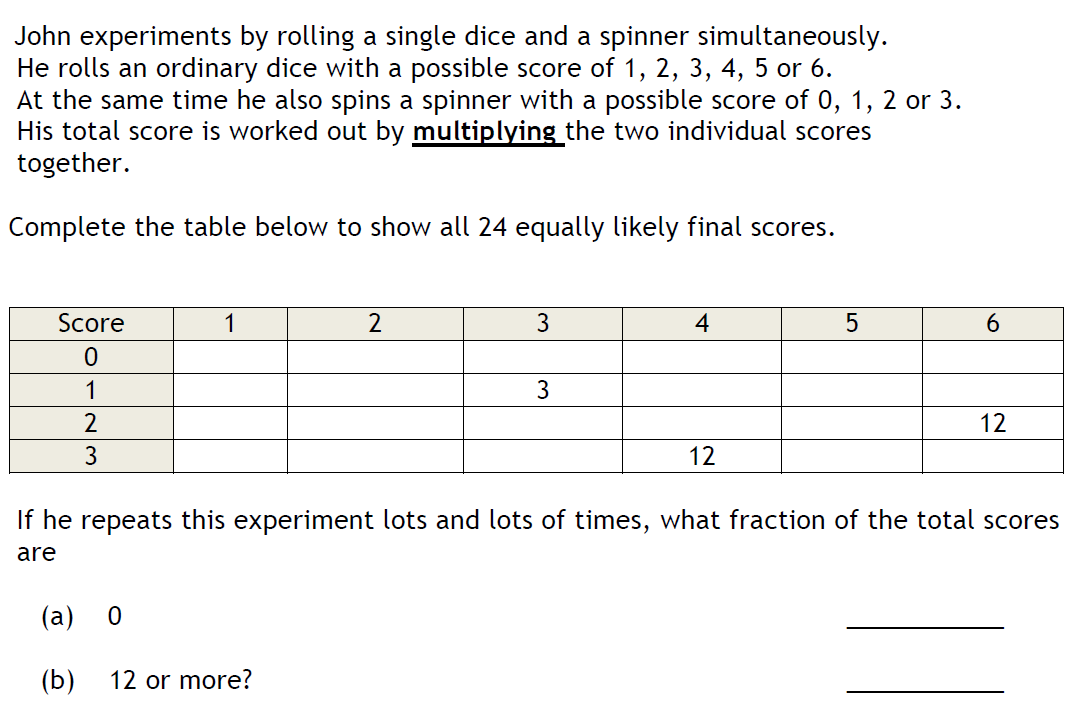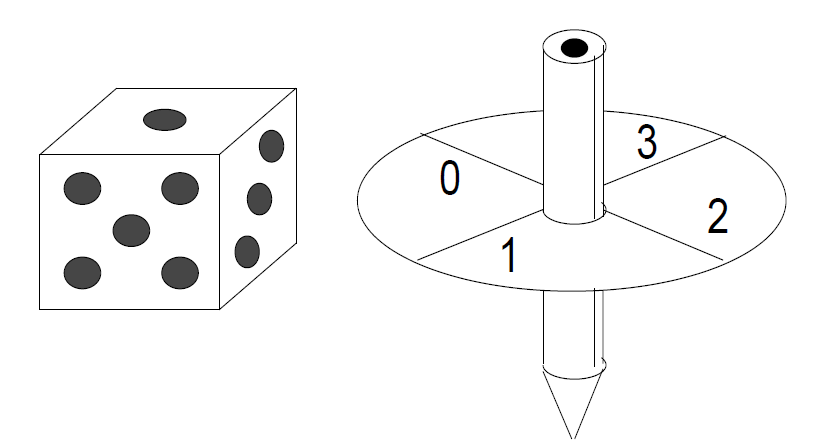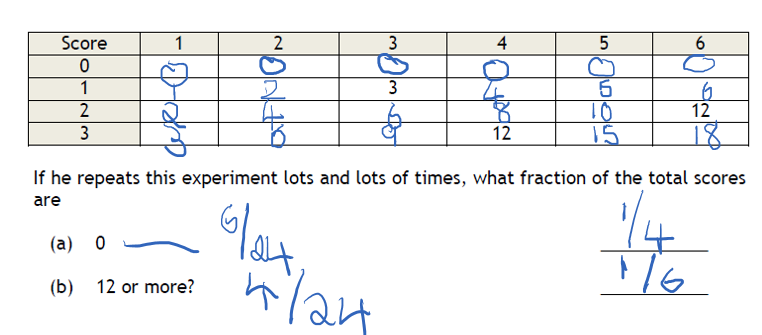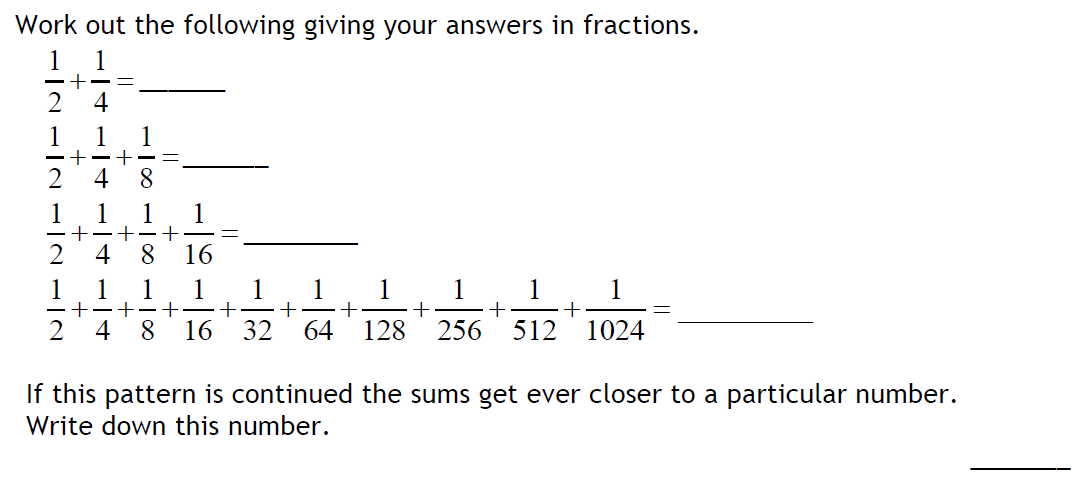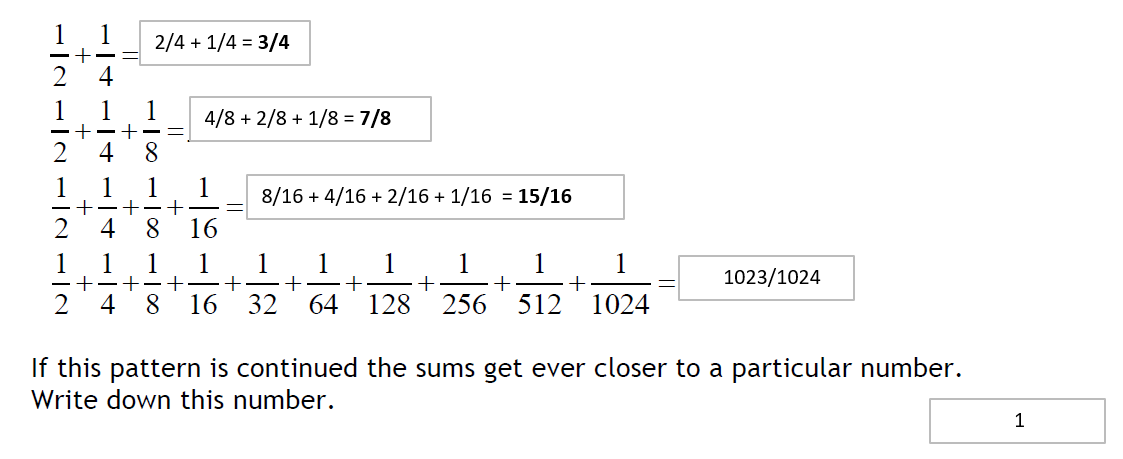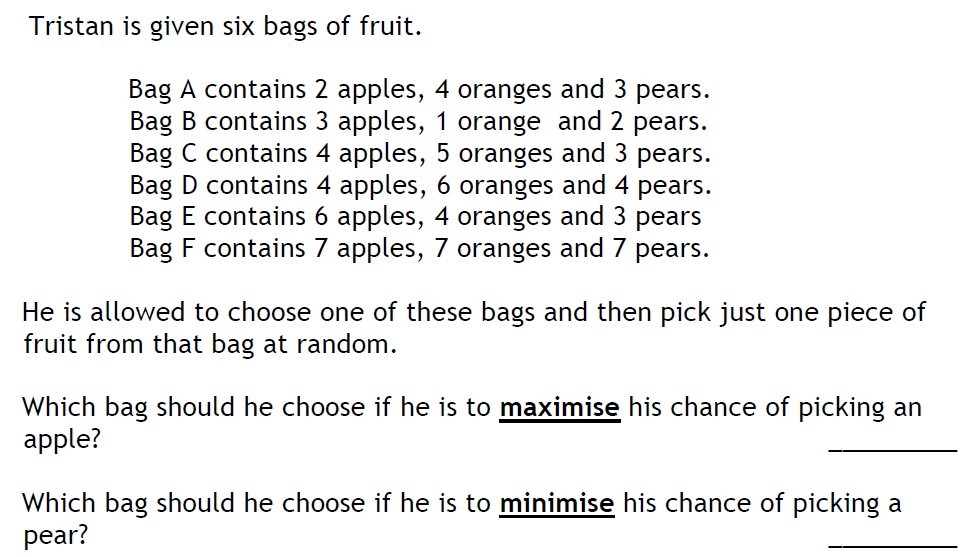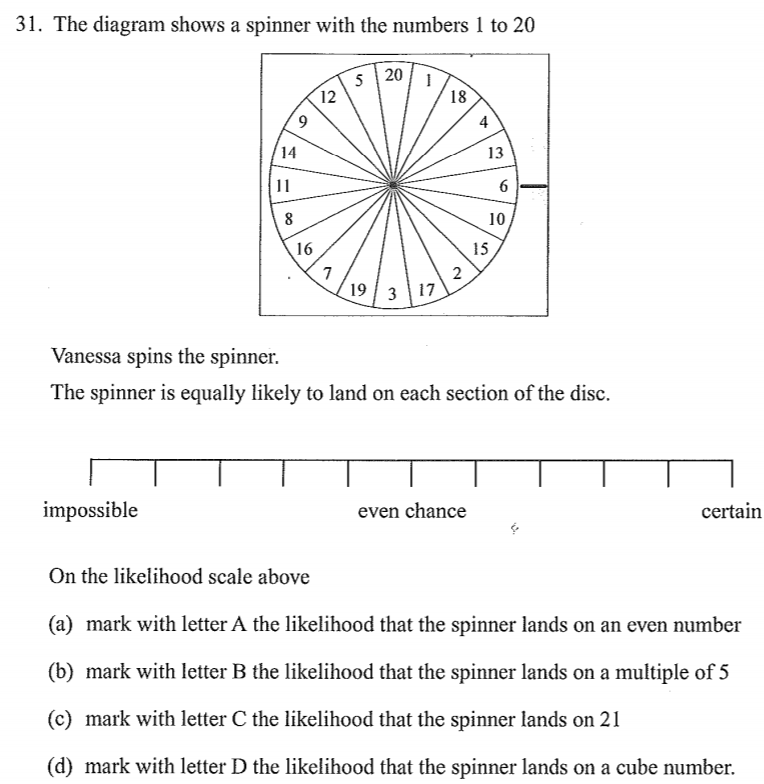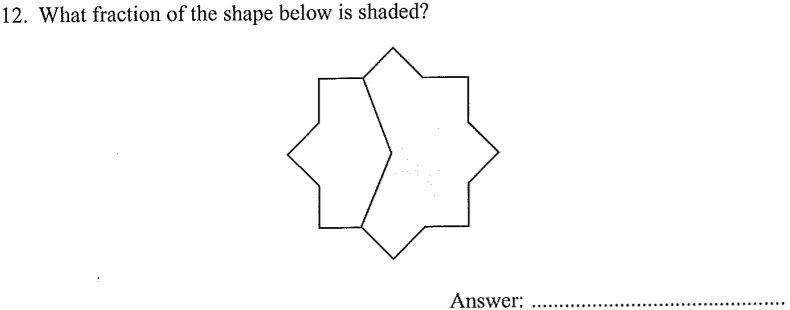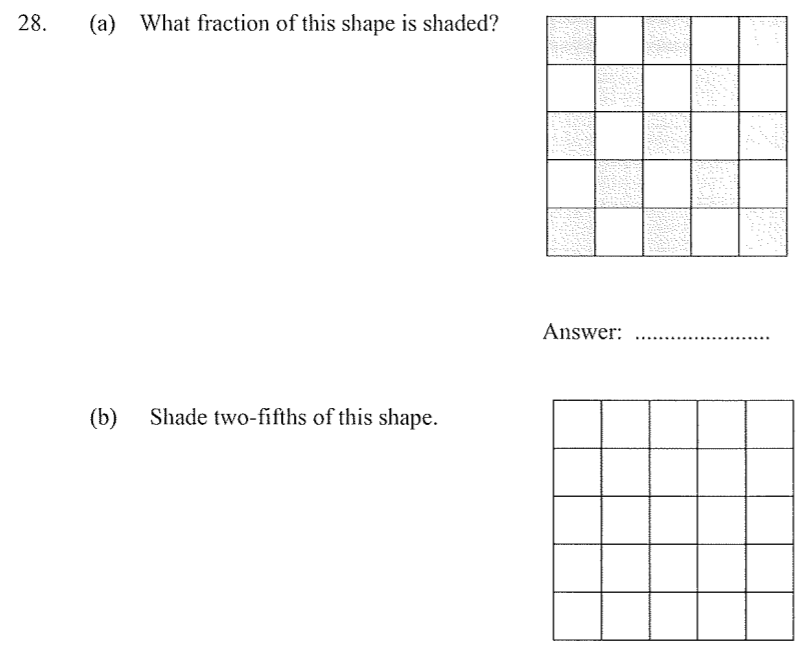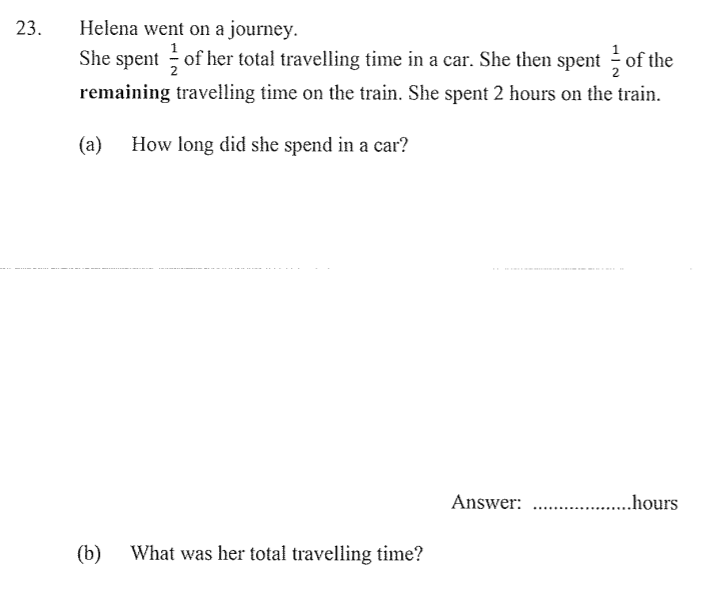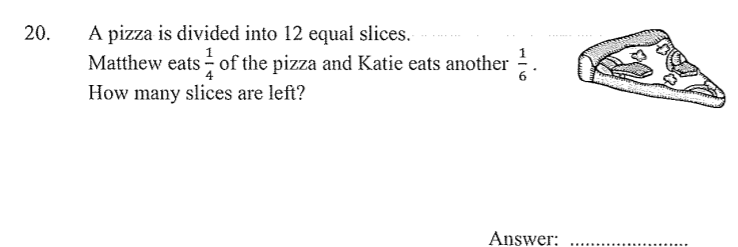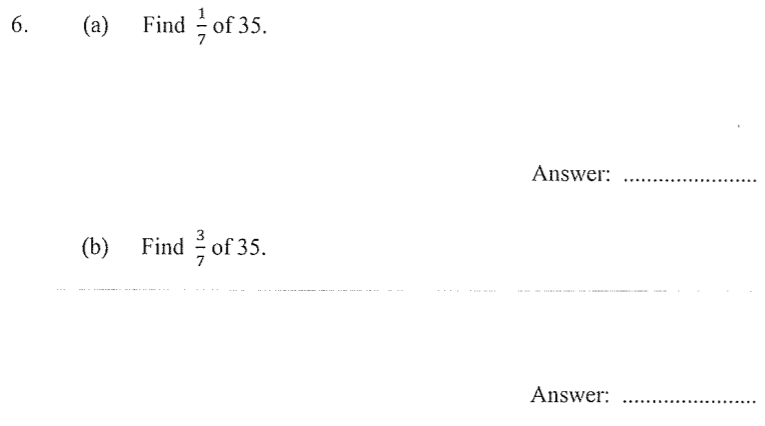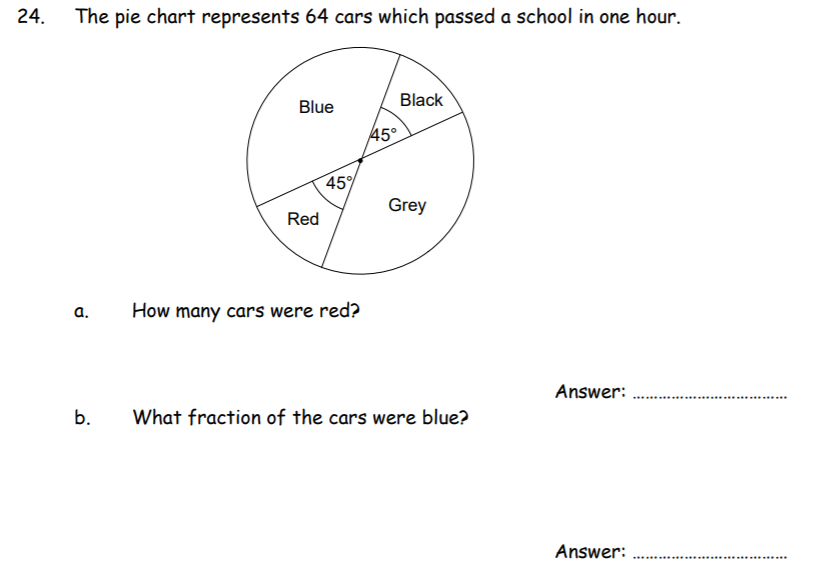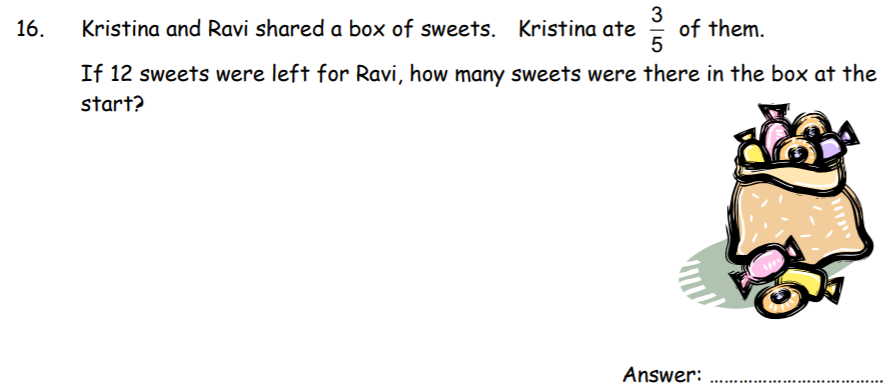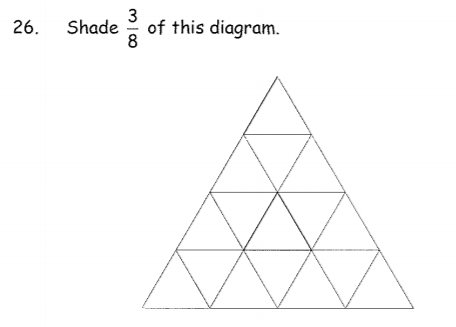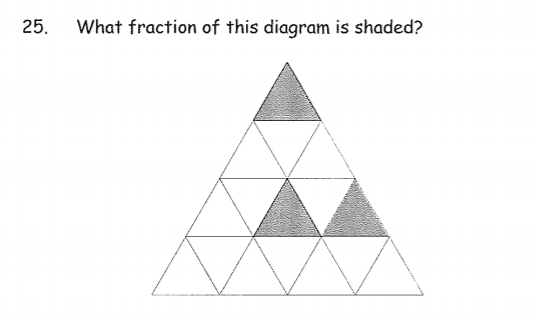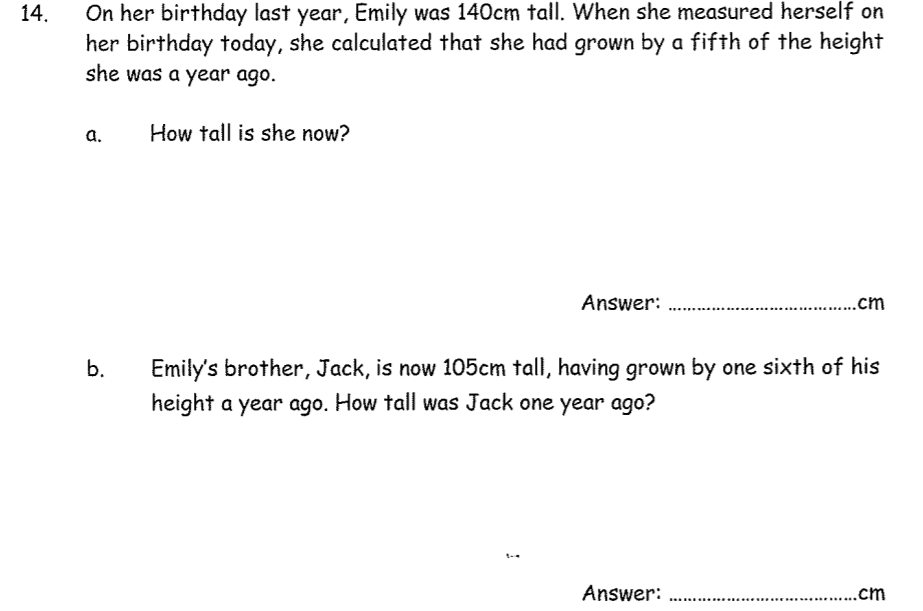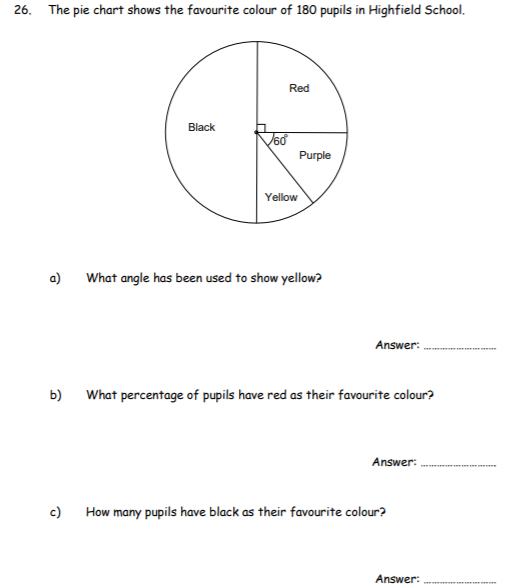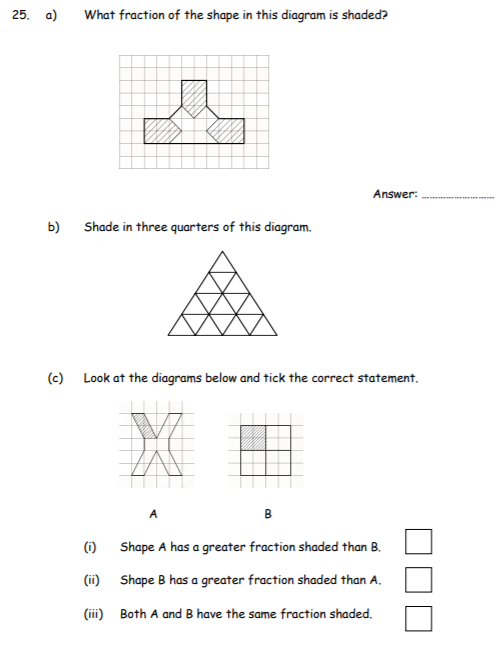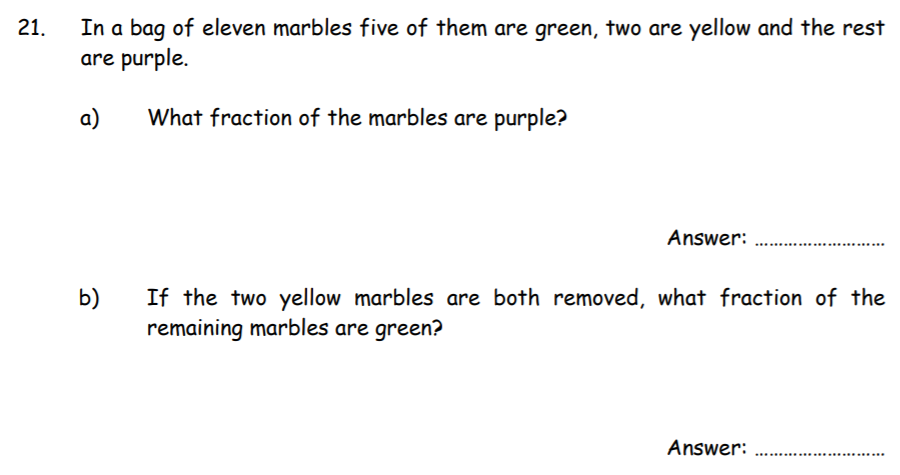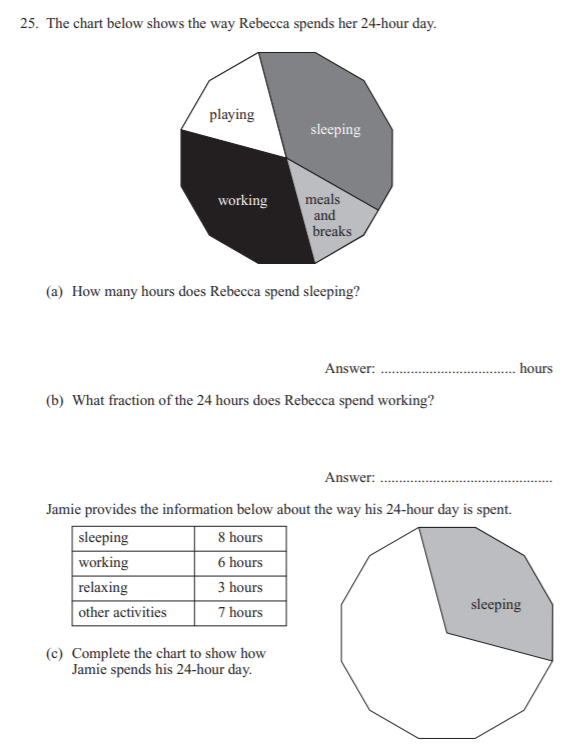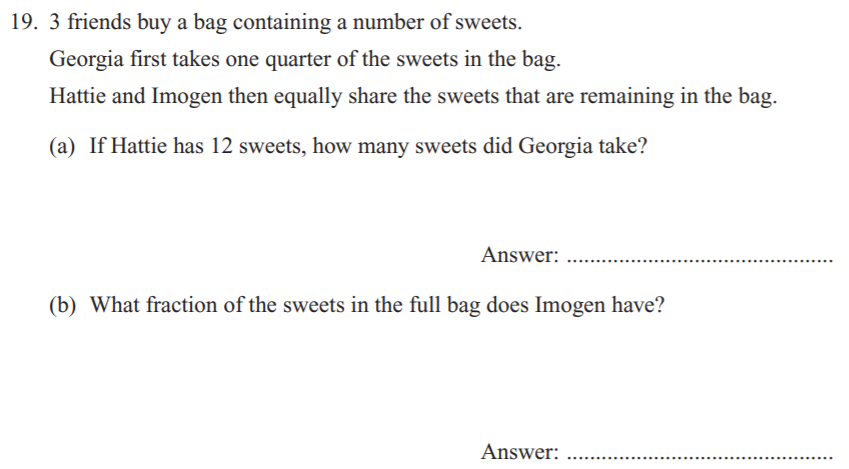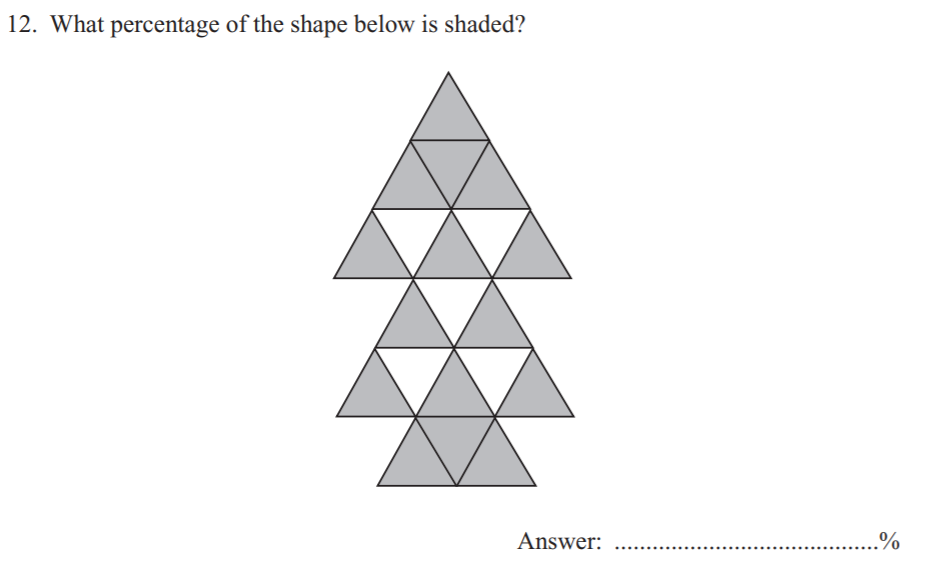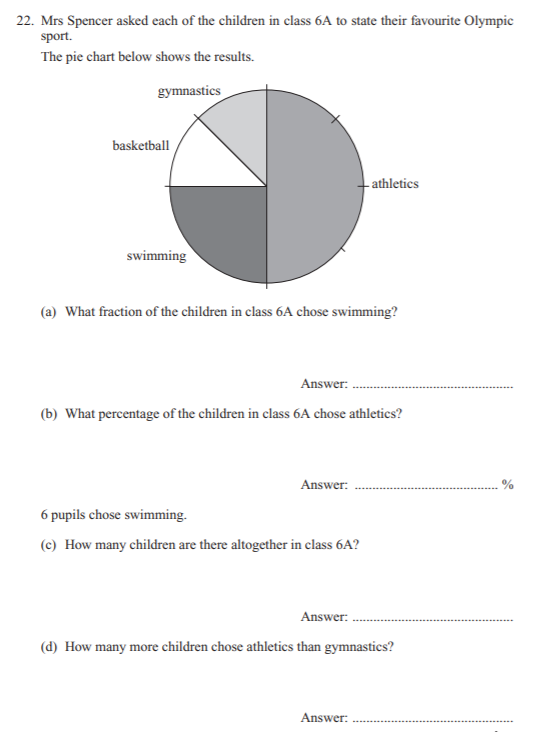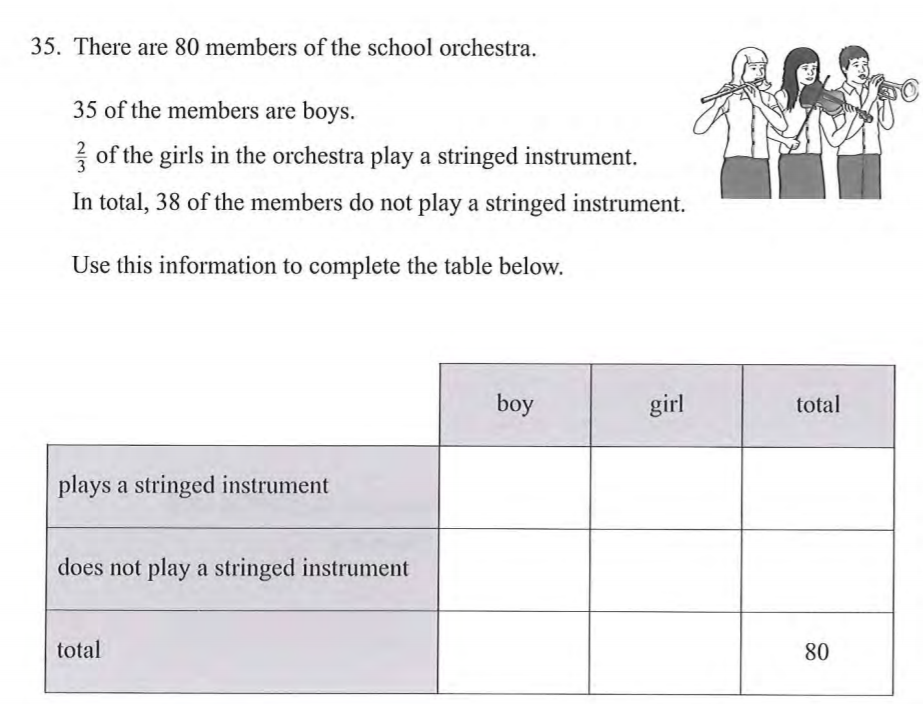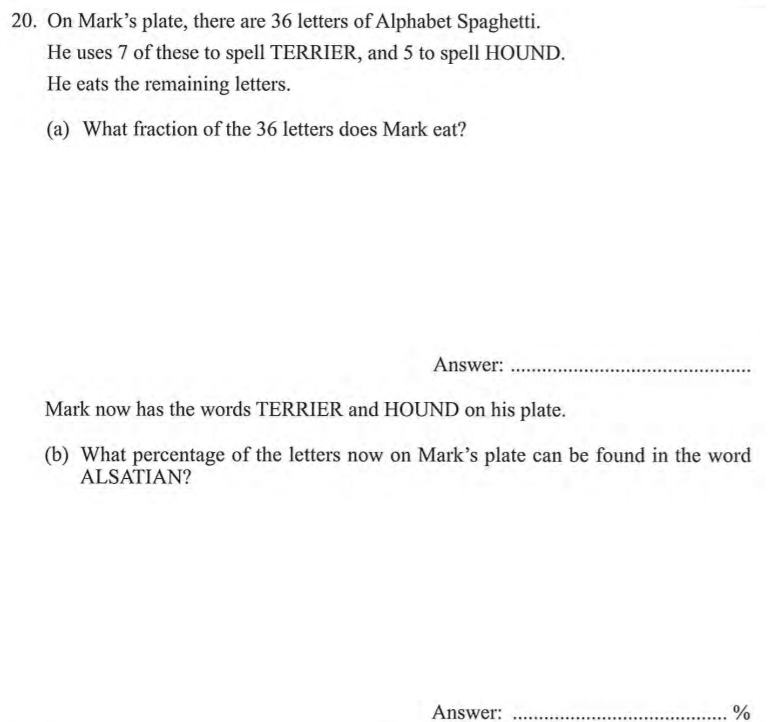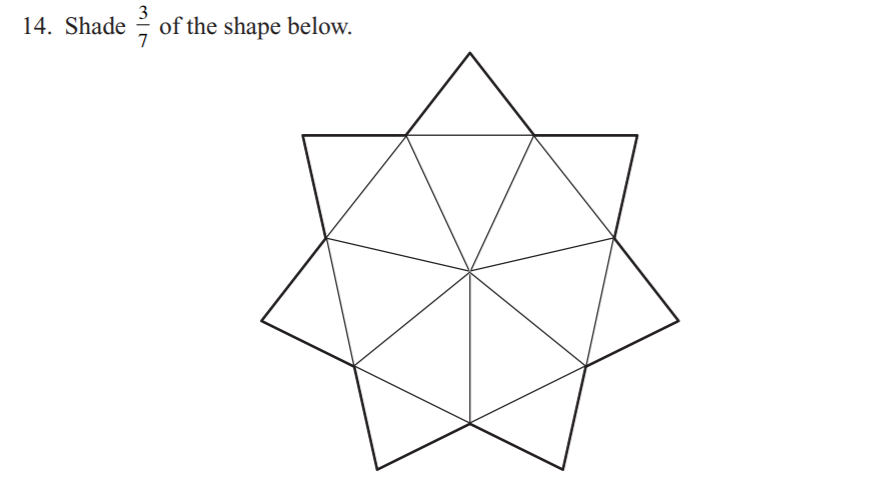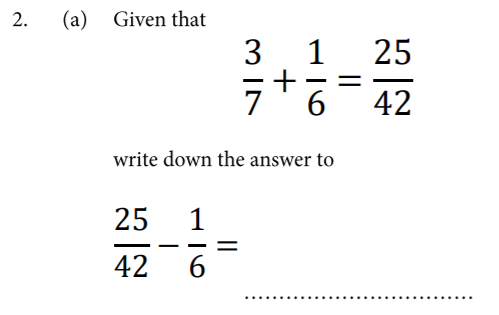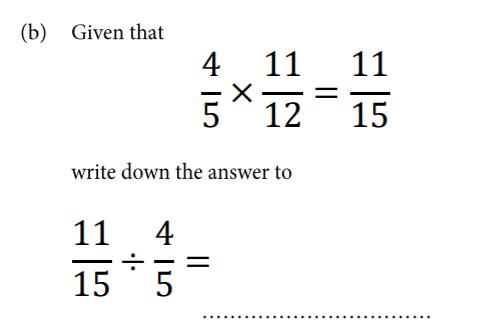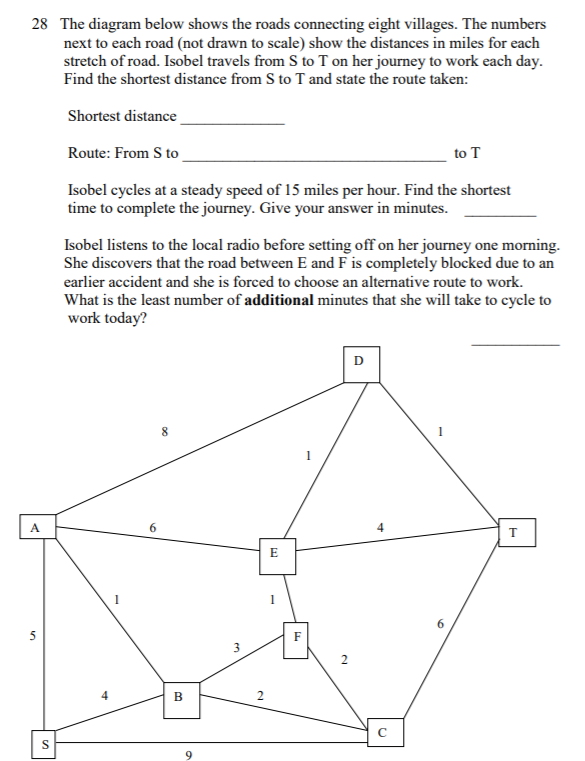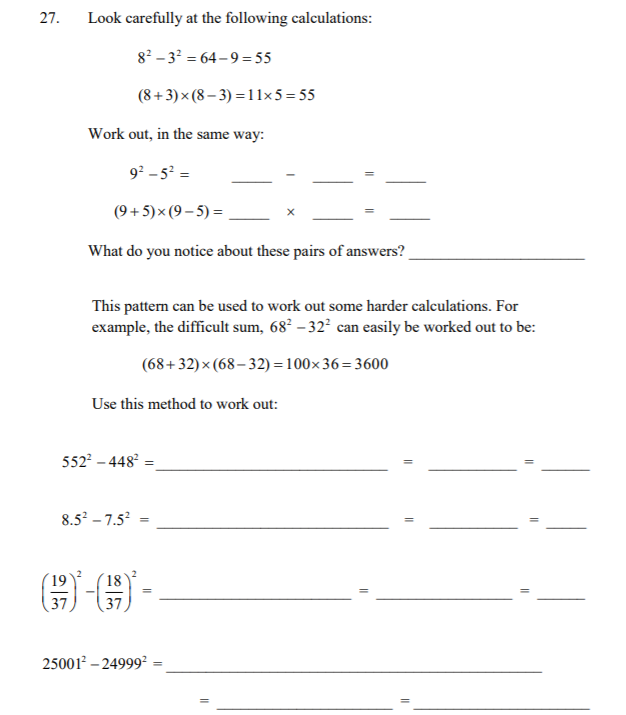84
120 pupils
2/5ths boys = 48 boys (120/5 * 2)
3/4s of boys write in pencil = 48 * 3/4 = 36
Girls = (120-48)-72
1/3 in pen so 24.
2/3 in pencil so 48
Total in Pencil = 36 + 48 = 84
B
£120 * 85/100 = £102
C
104 * 3/8 = 39
5/7 & 98 = 70
70-39 = 31
a) 0.09
b) 0.05
c) 0.375
If not sure, you can use “reverse bus stop”. So for example, calculate per below:

a) 55%
100% – 25% – 15% – 5%
b) 5
25% of 20 = 1/4 * 20
3/10 or 0.3
3 green/ total number of crayons
2/3
Red = 10/30 = 1/3
Green = 20/30 = 2/3
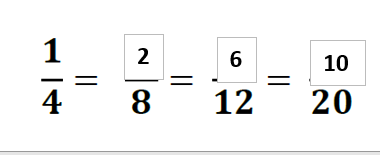
Golden rule here is that whatever you do to the numerator, you do the denominator.
So if the numerator doubles, the denominator doubles and visa versa. To keep the fraction the same
a) i) 1/3
3/9 = 1/3
a) ii) 30% shaded. Unshaded therefore = 70%
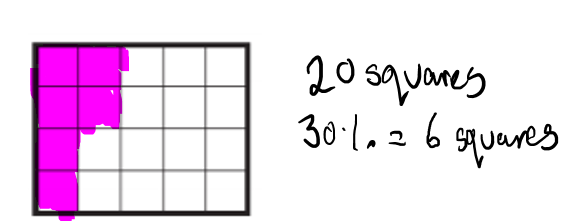
c) 50
10% of 500 = 50.
10/100 * 500
d) £127.50
85/100 * 150
Above formula to calculate 15% reduction
a) 0.03
b) 7
If 7.50 or above, then rounds to 8. Between 6.500 and 7.499, rounds to 7
c) 0.75
d) 0.07; 0.14; 0.306; 0.35; 0.4
e) 31/100
Remember 1.00 is 100% is 1/1. So 0.5 is 50% is 50/100. Work from there
a)i) 1/4
- 3/12. In its simplest form, this is 1/4
a)ii) 0.25
- Convert to a decimal = 0.25
b) i) See below
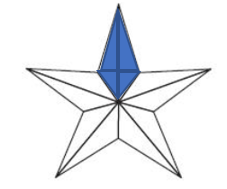
b) ii) 80%
13/40
- You have 1/4 shaded of the first square. 2/5ths shaded of the second square
- This is a question of being able to convert both fractions to the same denominator
- So this would be 20. 1/4 becomes 5/20 and 2/5ths is 8/20
- Then add both these together to get 13/40. Note its not 13/20 as you have to add the squares together which is unlike a normal fraction addition
200miles
- Calais to Paris is 320km. So 320 * 5/8 = number of miles
- 200miles. Can be done in 1 of 2 ways. Per the above or work out 1/8th which would be 40km. Then 5 * 40km = 200m
D C A B
A. 1/7
B. Very small / minimal chance
C. 1/6
D. 1/2
a) 1/15
- Convert to the same denominator
- So this would mean Tom 3/5 = 9/15 and Jerry 1/3 = 5/15
- In total, 14/15ths has been eaten leaving 1/15
b) 250g
- If Tom had 3/5 = 150g, then 1/5 = 50g
- Therefore 5/5 = 250g
630
-
- Calculate by doing 3/4 x 840
- “of” in maths means multiply
- 3/4 * 840/1
- Simplified……..3/1 * 210/1
- 630
£29.90
- First divide exactly by 2 as if they have 50/50. So this would be £23
- Then take 15% off Miguel and give this to Jon. So the revised share becomes 35% Miguel and 65% Jon
- So £46 * 65/100 =
11/35
- Convert to the lowest common denominator which is 35
- So 2/5s becomes 14/35 and 2/7s becomes 10/35
- Add together so 24/35
- This leaves 11/35
a) See below. 1.52
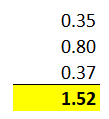
Convert to the same metric. So in this case, its better to convert to decimals
b) 0.3

For this, you should use reverse bus stop. So 70 goes outside the bus stop with 21 inside.
Then add zeros on so that you can work out the answer to 2 decimal places
Then change the answer by the number of decimal places you added. So if you added 2 zeros, then your answer of eg. 70 would become 0.7
a) 12.5%
3 films = 45 degrees
45/360 = 0.125 = 12.5%
b) 7/24
Focus on left hand side (so 0,1, & 4 together = 180 degrees)
0 children = 180 degrees – 45 – 30 = 105 degrees
105/360 = 21/72 = 7/24
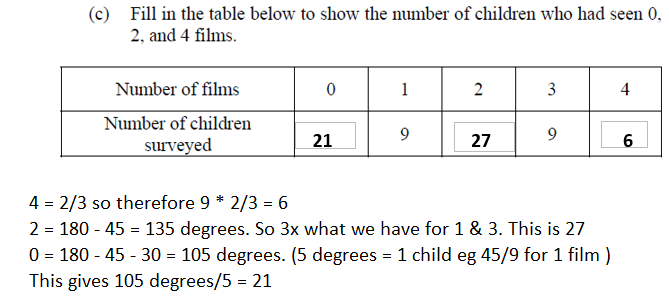
0.5 hours
- In one hour, Sachin can clean 1/3rd of the house
- In one hour, Peter can clean 1/6th of the house
- Convert to the same denominator which is 6
- So Sachin = 2/6 and Peter = 1/6
- Together, it takes 3/6 divided by 6/6 = 0.5 hours
15/26
When doing this type of question, you can’t answer 7.5/13 obviously. So the solution is to double each fraction and “force” a gap
So this becomes 14/26 and 16/26
Answer is 15/26
a) 1.32
0.75+0.4+0.17 = 1.32
Convert 2/5 & 17/100 to decimals
b) 16
Use the approach below which is “reverse bus stop”

a) 0.24
6/25 = 24/100 = 0.24
b) 1.20
Convert all to decimals
So 0.35 + 0.6 + 0.25
a) 9 members in each team
1-9
b) 21 teams
In every 100, there are 10 teams
So in 200, there are 20 teams
Plus 1 additional team 201-209. So 21 teams
c) 189 riders
In every 10 numbers, there are 9 riders. So in every 100, there are 90 riders.
So for 200, there are 180. Add on 9 riders for 201-209
Total 189
d) 18
To cover off the numbers 101 through to 109 and numbers 201 through to 209
e) 7/9ths
Total number of riders = 189
Total who finished = (189-42) = 147
So 147/189 = 21/27 = 7/9 (Using 7 has the highest common factor to simplify 147/189)
a) 8
- 30 socks – 10 white; 20 non-whites. Of the 20, 2/5th are blue
- So 20 * 2/5 = 8
b) 6 pairs
- Of the non-whites, 8 are blue so this leaves 12
- With 12 left, it could make 6 pairs
a) 0.24
12/50ths = 24/100 = 0.24
b) 12.5%
1/8th = 12.5%.
The way to get to this is “reverse bus stop”. So take the 8 as outside the bus stop and 1 inside. See below….
So 8 into 1 but then add on zeros so you can get to at least 2 digit answer or there is no remainder.
Then take the 125 and move the decimal 3 places to the left to give 0.125. (3 places because you added in 3 zeros)

a) 30°
Swimming & Golf together are 90°
Therefore, Golf is 90 – 60 =30
b) 1/8
Rugby = 45/360 = 9/72 = 1/8
c) 90
- Football = 180° – 45° = 135°
- 135/360 * 240/1
d) 220
- 1320 * 60/360
5/8
- 4 1/2 less 3 7/8
- Convert denominators to the same. So convert 4 1/2 to 8ths
- 4 4/8 less 3 7/8 = 5/8ths
a) 8
Mode = most common score. Scores were 9,6,8,4,8
b) 5
Range = 9-4
c) 7
9+6+8+4+8 = 35. Mean is average 35/5
d) 4
6.5 * 6 (6 being number of tests) = 39
French score is 39-35 = 4
e) 2/3
9/10; 6/10; 8/10; 4/10; 8/10; 4/10
He passed 4 out of 6 tests so 4/6 or 2/3
f) 35%
History score before was 4/10 – 40%
Now he scores 15/20 = 75%
Improvement = 35%
40% or 2/5
Prime Numbers between 1 & 20 are 2,3,5,7,11,13,17,19
This is 8 numbers out of 20. So as a proportion this is 40% or 8/20 = 4/10=2/5
Remember, 1 is not a Prime Number
a) 30°
180 – Australia – Africa = 180-90-60
b) 1/8
45/360 = 9/72 = 1/8
c) 30
180/1 * 60/360 = 180*1/6 = 30
d) 1000
Degrees for Europe = 180 – USA = 180-45 = 135
1600 * 225/360. Simplified this is 1600 * 45/72 = 15/24
1600/1 * 15/24
3/10; 0.305; 1/3; 35%
- Estimate approximately to the same denominator
- So , 0.333; 0.305; 0.35; 0.3
- This makes it easier to rank the numbers
1/4
4 parts of 16 shaded = 4/16 = 1/4
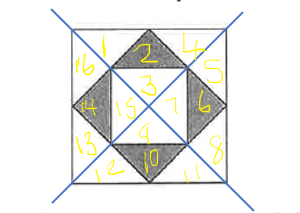
a) 4 plates
BB1, BB2, BB3, BB4
b) 16
Per above * 4 since you have AA1-4,BB1-4,CC1-4,DD1-4
c) 12
AB1,AB3,AC1,AC3,AD1,AD3,BA1,BA3,CA1,CA3,DA1,DA3
d) 3/8
Alphabetical order: AB,AC,AD,BC,BD,CD. Each one has 4 possible plates. So AB1,AB2,AB3,AB4,AC1,AC2 etc
Total number of possible plates = 24
24/64 = 3/8
1/20; 1/5; 1/4; 6/20; 3/2
- Use estimation if needed. So this would involve converting all of the fractions to the highest denominator which is 20
- 6/20; 4/20; 30/20; 1/20; 5/20
- This makes it easier to rank them
a) 1/8
45/360. Start off with 5 as the highest common denominator. Although there is a higher one
So 45/360 would become 9/72
Then 9/72 becomes 1/8
b) 40
Its the usual formula approach for this:
60/360 * 240/1
Then simplify each fraction (so 60/360 becomes 1/6)
Revised calculation is 1/6 * 240/1. Cross cancel and then multiply from there. See online videos on Youtube for 123tutors for further guidance
c) 450
Football is 135°. So 135/360 * 1200
a) 12
1/4 * 48/1
b) 2
48 * 1/2 = 24.
24 * 1/3 = 8
8 * 1/4 = 2
Remember of in maths means multiply
1.5
- 3 1/4 – 1 3/4 = 1 1/2
- As a decimal, this is 1.5
18
- A=5/8; P=3/8
- Pears therefore = 3/8 * 48/1
- Pears = 18
five twelfths; 0.65; 0.7; 3/4; 4/5
Can convert all of these to fractions if it helps
7/10 ; 3/4; 4/5; 13/20; 5/12
1/3
- Total number of squares = 24
- Shaded squares = 8
- Fraction shaded = 8/24 = 1/3
15
- 24/1 * 5/8
- Simplified = 3/1 * 5/1 = 15
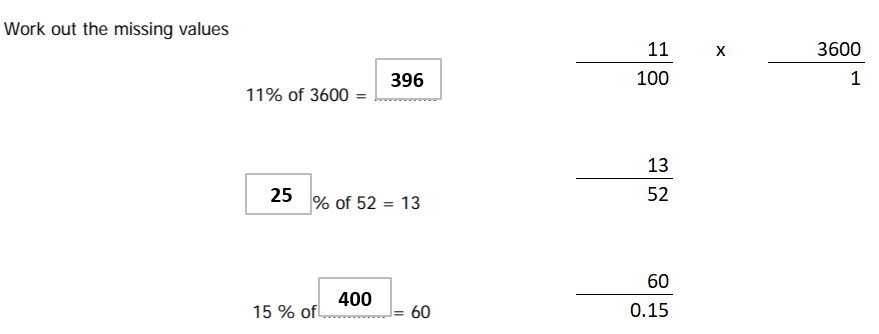
For first question, use fractions approach remembering to simplify and cross cancel. (See prior question in this paper for illustration)
For second question, its the same as 13/52
Final question convert 15% to 0.15. Then 60/0.15
a) 24
Half of the 48 students so 24
b) 1/4
c) 4
Pizza is about 1/3 of 1/4.
1/4 = 12 children given 1/2 = 24
So 1/3 of 12 = 4
1/2
- 1/5th to friend = 2/10ths
- 3/10ths to other friends
- Total left is 5/10
- Always simplify
36
-
-
- 15/100 * 240/1
- Simplify…3/20 * 240/1
- 3/1 * 12/1
- 36
-
1 25/36
-
-
-
-
- First convert to improper fraction:
- 9/4 – 5/9
- Convert to Lowest Common Denominator
- 81/36 – 20/36
- 61/36
- 1 25/36
-
-
-
13/24
-
- Convert to Lowest Common Denominator
- 9/24 + 4/24
- 13/24
24
- 32 men = 1/4
- 3/4 women = 3 x 32 = 96
- 25% of women bought a newspaper. So 25% or 1/4 of 96
3
- Convert to 10ths and then back again
- So that would be 6/10 + 3/10
- This would convert back to 3/5 + 3/10
3/12; 2/8; 1/4
- Best way to compare fractions is to convert to the Lowest Common Denominator
- But this is tricky with tight timelines
- Therefore look for a common denominator where possible
- 3/12; 2/8 & 1/4
0.029; 0.23; 0.25; 0.66; 0.667
- Convert to the same metric if required. This makes the exercise easier
- So, can convert all of these to decimals
- 0.23, 0.667, 0.029, 0.66, 0.25
a) 1/3
b) 7/8
c) 1/3
d) 6 4/7
A
- 0.3 = 3/10
C
- Always use dummy numbers if not sure. So if we assume 40 children in class and 1/4 are girls, then thats 10 girls
- There are therefore 30 boys. So ratio girls to boys is 1:3
B
- For 0.8, convert fractions to either 10ths or 100ths.
- Convert 4/5ths to 10ths = 8/10 = 0.8
a) 45
Fail = 15 boys = 1/4 of the pie or 90 degrees
Therefore, if 1/4 = 15, 3/4 = 45
b) Charlie is incorrect because you do not know how many boys and how many girls there are in Year 7. This is required to work out the answer. There may for example be 24 boys and only 5 girls. This would mean 6 boys fail the test and less than 5 girls fail the test.
Test 1
- 60/80 = 75% (60/80 *100/1)
- 70/100 = 70% (70/100 * 100/1)

Convert all numbers to the same metric if needed when working through this style of question
a. 10 seconds
If turn is 360 degrees every 40 seconds, 90 degrees as a right angle would take 1/4 of 40 = 10 seconds
b. 84 turns
In 56 minutes, the sails make 56/1 * 60/40 turns
Again, use of fractions to calculate these types of questions
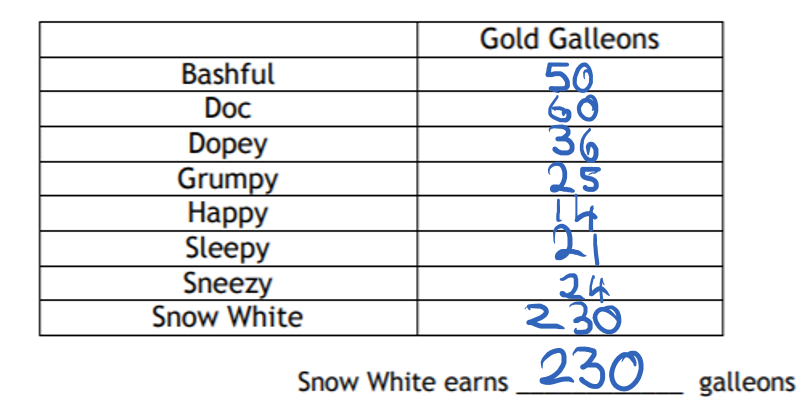
Start with Sneezy as this is given as 24 and work from there
Grumpy gets 1 more so is on 25 etc etc
£32
- Working backwards, 25% discount would mean discount on ticket cost was 25/75 * 30/1 = £10
- Full Price Child = £40
- Senior Citizen therefore pays 80/100 * 40/1 = £32
8 <sup>1</sup>/<sub>3</sub>
If the question was not with the same denominator, then the approach would be to convert to an Improper fraction and then from there, the Lowest Common Denominator and then subtract. But this question is relatively easy
Bag B – Apple Maximum Chance
Bag E – Pear Minimum Chance

£660
120/100 * 550/1
Simplify the calculation per normal rules of simplification and cross cancellation and then calculate
£1000
100/120 * 1200/1
70 hours
Process:
- If Lazy Living = 2/7ths, Celeb Gossip is 5/7
- 5/7 * 98/1
- Simplified this is = 5/1 * 14/1
- This is 70
9/25
- The way to address this is to convert all of the fractions to their simplest form;
- So again…..HCF ! This is such a crucial part of Maths. Understanding your times tables inside out;
- This would give us the following:
3/5 3/5 3/5 9/25 3/5
> So for example, the first fraction 12/20 has the HCF of 4. (12/4)/(20/4) = 3/5
See below:

a) The probability of A is 10/20 = 1/2 = Even . (10 numbers are even. 10 are odd)
b) The probability of B is 4/20 = 1/5 . (4 numbers comply. 5,10,15,20)
c) The probability of C is 0/20 = 0. (There is no 21 on the spinner)
d) The probability of D is 2/20 = 1/10 . (2 numbers comply. 1 and 8)
1.5
1/10 * 5 = 0.5 (Move decimal one place to the left when dividing
1/5 of 10 = 2
So difference is 1.5
5/8ths is shaded
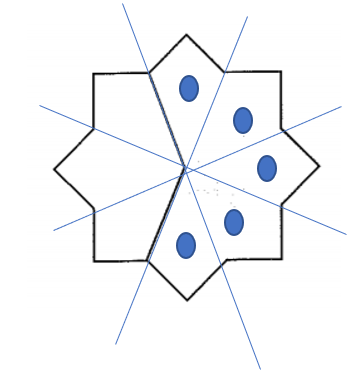
128
Use the following method and remember “of” means multiply in maths
3/4 * 1/96
This gives
3/384
Simplified….
128/1
a) 13/25
In total, its a 5×5 box so 25 boxes
Of these, 13/25 are shaded
b) See below
2/5ths = 10/25ths so 10 boxes to shade
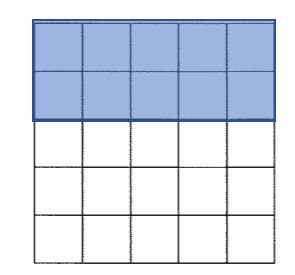
a) 4 hours
If she spent 2 hours on the train and this represents 1/2 of the remaining time, then 2 hours = 1/4 of the time
Therefore if 1/4 = 2hours, 1/2 = 4hours
b) 8 hours
7 slices
- This question is again one related to HCF and multiples.
- So convert to 12ths to make the question easier
- Matthew eats 1/4 = 3/12
- Katie eats 1/6 = 2/12
- So this leaves 7 slices
0.2; 1/5; 0.027
- With these types of questions, its sometimes a good idea to convert all the options to fractions
- This would give the following:
- 1/5 ; 1/5; 2/5; 3/8; 27/1000
If not sure, then an alternative approach is to convert all the numbers to the same denominator
a) 5
1/7 * 35/1
Always cross cancel. So the 7 and 35 can be simplified further….
1/1 * 5/1
b) 21
The best approach is given that the answer to a) is 7, then 3/7ths would be 3 * 7 = 21
a) 8
-
-
-
- If 64 cars in total, then the following equation will be used to calculate the number of red cars
- 64/1 * 45/360.
- After cross cancellation, this is simplified to:
- 64/1 * 5/40
- Further cross cancellation:
- 8/1 * 1/1
-
-
b) 3/8
- The key here is to remember that the opposite angles when 2 lines cross, create equal angles
- So given Black and Red are 45º each, this gives 90° in total
- So remaining in the circle is 360 – 90 = 270
- Each angle must therefore be 270/2 = 135
- Every 45 degrees = 1/8th. So 135 = 3/8
30
A classic question on the concept of fractions. If Ravi is left with 12 sweets and this equals 2/5, then you have to calculate what 1/5 equals. This is 12/2 so it equals 6 sweets
Therefore, each 1/5 = 6 sweets. There were therefore 30 sweets to start with in the box

Convert all the cards to the same metric if that helps to evaluate
18
Work these questions always with the following approach:
3/8 * 48/1
Then simplify to:
3/1 * 6/1
Easier to get to the answer of 18
2/5 1/2 5/8
- Convert all fractions to the lowest common denominator
- The LCD of 5, 8 & 2 is 40. Always easiest to work by going through the highest of the 3 numbers. So count in 8s
- Revised fractions are as per follows so it now becomes much easier to rank these:
16/40 25/40 20/40
See below
16 triangles. Therefore 6 shaded. 6/16 = 3/8
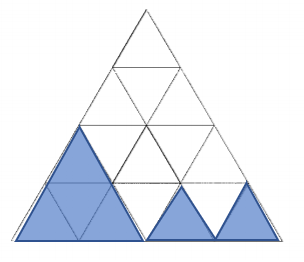
3/16
Total number of small triangles is 16. Of this, 3 are shaded
a) 168cm
140/1 * 6/5
b) 90cm
105/1 * 6/7
3/5 29/45 2/3
- Convert to the same denominator to make it easier to compare
- Lowest common Multiple of 3, 5 & 45 is 45.
- 2/3 becomes 30/45
- 3/5 becomes 27/45
2/3
- Yet another question which requires the possible use of HCF. You are looking at 60 seconds and 40 seconds.
- The highest common factor of 60 and 40 is 20.
- 6o seconds is split into 3 lots of 20. So denominator is 3
- 40 represents 2 lots. So fraction is 2/3
a) 30º
- Yellow + Purple is a right angle so is 90º
- Therefore, Yellow is 30º
b) 25%
- 100% for the pie chart. Therefore, Red occupies 1/4 of this.
- 100/1 * 1/4
c) 90
-
- 180/360 * 180/1
- This is 180 degrees/360 degrees * 180. The equation above can be simplified and you should always do this
- 1/1 * 90/1
a) 15/23
- Consider total area of shape = 23 squares
- Shaded area is equal on all 3 sides. Each side has 5 shaded squares
- Total shaded area = 15/23
b) See below
- 16 triangles in total
- 3/4 shaded = 12/16 shaded
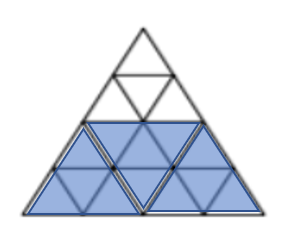
c) i) Shape A DOES NOT have a greater fraction shaded than Shape B
- Shape A – 10 squares altogether. 2/10 shaded = 1/5th shaded
- Shape B – 16 squares altogether. 4/16 shaded = 1/4 shaded
c) ii) Shape B DOES have a greater fraction shaded than Shape A. (Inverse of the statement for i). So this is the right statement
c) iii) This is NOT CORRECT
a) 4/11
5G, 2Y, 4P
b) 5/9
If 2Y is removed, it leaves 5G+4P.
12
If 3/5 were eaten and this represents 18, then each 1/5 is equal to 6. (18/3). Therefore, there were 30 sweets to start with and 12 remain uneaten
3.025 3 1/4 3.34 3 3/4
Try and convert all numbers to the same metric if possible. So in this case, lets convert all the numbers to decimals.
3.25 3.34 3.75 3.025
It becomes far easier to rank smallest to largest then
90
Work out as 2/7 * 315/1
Simplify this to 2/1 * 45/1
Far easier to then calculate
a) 9 hours
The key to note here is that the shape is split into 12. So its a Dodecagon. Each line represents 2 hours of the day. Sleep occupies 4 1/2 lines so in total, that is 4.5 * 2 = 9 hours
b) 1/3
Working = 8 hours. So as a fraction , its 8/24 = 1/3
c) See below
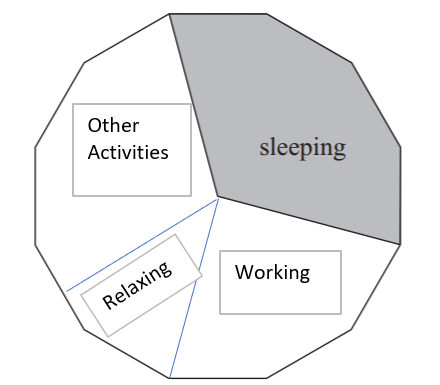
a) 8
Hattie = 12. Therefore, Imogen = 12. This is 24 in total. If 24 represents 3/4, then each quarter is 24/3 = 8. Total sweets would have been 32. Georgia therefore took 8
b) 3/8
12/32 = 6/16 = 3/8
3/4
Count the number of triangles = 20
Shaded = 15
Shaded = 15/20 = 3/4. Always simplify unless otherwise stated
27
3/8 * 72/1 = 3/1 * 9/1 = 27
a) 1/4
Right angle
b) 50%
Exactly half
c) 24
If 6 chose swimming = 25%, then 100% = 6 x 4 = 24
d) 9
If swimming = 6, gymnastics = 3. Therefore, athletics = 12. 12=3
36
Remember, “of” means multiplication in maths. So the simple way is 2/3 x 54/1. ALWAYS Cross Cancel where possible:
2/1 x 18/1 = 36
a) 800
Move decimal 3 places to the right. So it becomes 800
b) 3.49
Move decimal 2 places to the left
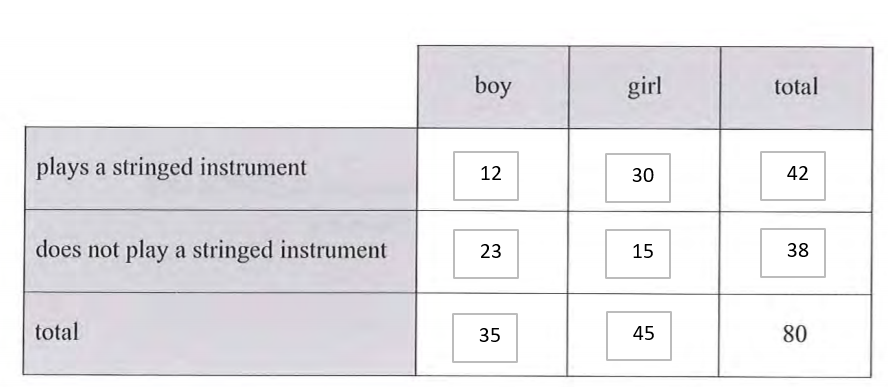
Just read one statement at a time and use it to complete the table where possible
- 35 Boys. Therefore , 45 girls
- 2/3 of girls play stringed instrument. So 45 x 2/3 = 30. Which means 15 do not
- 38 do not play stringed instrument. Therefore, for boys, its 38 – 15 = 23
a) 24/36 = 2/3
Remember question is asking for how much he eats. So he used 12 letters. Leaving 24. Always simplify your answer if it doesn’t specify to leave it as the long hand version
b) 25%
ALSATIAN letters in common to TERRIER & HOUND are T,I & N. So 12 letters on Marks Plate. Of these, 3 letters can be found in ALSATIAN. So its 3/12 which as a % is 25%
32
If 24 = 3/4 then he has made 3 of his full amount. So each “portion” is worth 8. Total therefore Denominator x 8
30
Use the approach of 5/8 * 48/1
Then cross cancellation etc and simplify this to 5/1 * 6/1
Cross cancellation is essential as it makes the calculation far easier overall and reduces error rates
a) 6 bales
3/4 of a bale ever day. Therefore 3/4 x 8 /1 = 24/4 = 6 whole bales
Fraction multiplication taking 8 as 8/1
b) To eat 27 bales, it takes 36 days
For 6 bales = 8 days. Therefore, you can look at it as ratios if it makes it easier 3:4. So if 27 = the “3” in the ratio, then each part is worth 9. The number of days is the “4” so in this case, its 9×4 = 36
6 shaded triangles
Firstly count the number of triangles = 14
Then students should identify that 14 is a multiple of 7. Therefore 3/7ths = 6/14
a) 3/7
The way to look at this is how you would approach a simpler question: Lets say….10+6 = 16. So 16-6=10
Therefore, the same approach says that 3/7ths is the answer. Proven, you can do the following:
25/42 – 1/6 = 25/42 – 7/42 = 18/42 = 3/7
b) 11/12
Same test using Example numbers. 3X7=21. Therefore, 21/3 = 7 .
The examples given above are simply that. Its easier to think of the same principles using examples and then substitute in the real question numbers rather than think of the question as a tricky fractions question and try and work it out.
i) 4/5
ii) 8/10
iii) 20/25
You have to work backwards. You know x/10 = 12/15. So the denominator went up by 50% or 1/2 from x/10 to 12/15. Or the other way round, from 15 to 10 is 2/3rds. So you would do this with the numerator of 12 for which 2/3rds is 8
So 8/10
This when you simplify it would be 4/5 . But you must pay attention to the change (working backwards), from 8 to 4 which is half. Therefore, you also half the denominator of 10 to 5
Finally, 12/15 = 4/5 so if you apply this principle, 20 = 4/5ths of the final number. 20 in 4ths is 5 per portion. 5 x 5 = 25. Our final fraction is 20/25
i) 10 miles
ii) S to B to F to E to D to T
The thing to note here is that the map is not drawn to scale so extra attention has to be paid to the miles between different points
iii) 40 minutes
Time = Distance/ Speed. So substituting into the formula, Time = 10/15 which = 2/3 of 1 Hour (10/15 x 60). So thats 40 minutes
iv) 8 minutes
The revised route is S-B-C-T. So an extra 2 miles
This means 12/15 of 1 hour so 12/15 x 60 = 48 minutes
Difference being 8 minutes
Completed blanks in the following order
81-25=56
14×4=56
They are the same. (NOTE: This is a nice trick to remember). Follow the example guideline.
(552+448)x(552-448) = 1000 x 104 = 104,000
(8.5+7.5)x(8.5-7.5) = 16 x 1 = 16
(19/37+18/37)x(19/37-18/37) = 37/37 x 1/37 = 1/37
(25001+24999)x(25001-24999) = 50,000 x 2 = 100,000
NOTE: The above is a great approach to remember for future questions.
34
With word questions like this, just start off with one sentence at a time:
- 2/5 get off at stop 1 = 35/5 *2 = 14 passengers get off. So this leaves 21. 7 get on so this gives 28
- 28 remaining and 1/4 get off. So this is 7. Leaving 21. 13 get on so this gives 34
Many students do get confused because of the number of words and phases to this journey. However, just methodically do one sentence at a time
5/12
So this is a relatively common question for some schools. Find the LCM of the denominators 3 & 2. This is 6.
Therefore, x 1/3 by 2 and 1/2 by 3 which gives 2/6 and 3/6. If this doesn’t give a fraction in between the 2 fractions, then x2 for each fraction
This gives 4/12 an 6/12
This “forces” out a middle fraction of 5/12.
Note: You have to have the same denominator in order to solve this question

